Interactions between Dislocations and Boundaries during Deformation
Abstract
1. Introduction
- The long-range elastic stress field between the dislocations and the boundaries, i.e., the image force;
- The dislocation accommodations to the boundaries when impinging on boundaries;
- The resistance of the adjacent crystal due to different orientations, Bravais lattices and lattice parameters.
- The dislocations can only transmit across the non-metallic compound particle interface when the particle size is smaller than a critical value, which is always several nanometers;
- The slip are able to transmit across the non-metallic compound lamellar interface by slip steps only if the lamellar thickness is fine enough, otherwise the fracture of lamellae may occur due to the stress concentration of dislocation pile-ups.
- Summary of boundary structure.
- Transmission mechanisms of dislocation–boundary interactions in coarse-grained metals.
- Interaction behaviors and influencing factors between dislocations and boundaries in coarse-grained metals.
- Effect of grain size: dislocation-boundary interaction behaviors and influencing factors in ultrafine-grained and nano-grained metals.
- Applications and characterization techniques.
- Summary and outlook.
2. Structure of Boundary
2.1. Grain Boundary
2.2. Dislocation Boundary Introduced during Deformation
2.3. Twin Boundary
2.4. Interface between Different Phases
- Fully coherent interface
- b.
- Partly coherent interface
- c.
- Incoherent interface
3. Interactions between Dislocation and Boundary
- When dislocations move towards the boundary, there exists a force against dislocation motion derived from the long-range elastic stress field between dislocations and the boundary, which is called the image force. The image force makes the group of following dislocations piled up in front of a boundary, and may increase due to the interaction between the leading dislocation and the boundary;
- Once impinging on the boundary, the incoming dislocation will face another resistance originated from the interaction between the dislocation and the boundary;
- When the dislocation is about to emit into the adjacent grain, the dislocation has to accommodate its orientation and Bravais lattice. This situation is more complicated for phase interface, whose resistance is stronger than those of grain boundaries and twin boundaries due to the dislocation accommodation to a different phase.
3.1. Dislocation–Grain Boundary Interactions in Coarse-Grained Metals
3.1.1. Basic
3.1.2. Dislocation Transmission Mechanisms across a Grain Boundary
- Misorientation
- b.
- Geometrical condition
- c.
- Energy
3.1.3. Other Influencing Factors
- Dislocation type
- b.
- Strain and strain rate
3.2. Dislocation–Grain Boundary Interactions in Ultrafine-Grained and Nano-Grained Metals
3.3. Dislocation–Twin Boundary Interactions in Coarse-Grained Metals
3.3.1. Basic
3.3.2. Dislocation Transmission Mechanisms across a Coherent Twin Boundary
- Dislocation type
- The cross-slip mode denotes the transmission of perfect screw dislocations whose Burgers vector is parallel to the coherent twin boundary plane. In this mode, the screw dislocations are usually derived from grain boundaries, which are always activated favorably by applying tension/compression parallel to the coherent twin boundary. Then, they may transmit across a twin boundary by cross-slip without leaving residual dislocations and are ultimately impeded by the grain boundary at the opposite side;
- For the hard mode, the Burgers vector of incoming dislocations is inclined to the coherent twin boundary plane. This may require residual dislocations left in the twin boundary and a higher critical stress to transmit across a coherent twin boundary;
- Dislocations with a slip plane parallel to the twin boundary are defined as the soft mode, which occurs when the maximum shear stress is parallel to the coherent twin plane. The dislocations may glide on the coherent twin boundary leading to migration of the twin boundary by twinning or detwinning.
- b.
- Geometrical condition
- c.
- Stacking fault energy
3.4. Dislocation–Twin Boundary Interactions in Nanotwinned Metals
3.5. Dislocation–Phase Interface Interactions
3.5.1. Particle
- Particle at the nano-scale
- b.
- Particle at the micro-scale
3.5.2. Lamella
- Interface between two different metallic phases
- b.
- Non-metallic compound lamellar interface
- Elastic deformation occurs in both ferrite and cementite phases;
- The dislocations slip in each lamella interior independently and then the slip transfers appear by the yielding of cementite lamellae.
4. Interactions between Deformation Twin and Boundary
- Since the twin nucleation and growth are the result of partial dislocation motion, the dislocation slip must be active prior to the twin formations and the stress level for the twin-boundary interaction is higher compared with that for the dislocation–boundary interaction [148];
- Since the emitted twin keeps the same variant as the incident one, the resolved shear stress and slip system of the adjacent grains should be favorable for the twin nucleation of the same variant. In this case, both the crystals and twin pairs on each side of the boundary should have small misorientation.
4.1. Deformation Twin-Grain Boundary Interactions in Coarse-Grained Metals
4.1.1. Basic
4.1.2. Twin Transmission Mechanisms across a Grain Boundary
- Misorientation
- b.
- Other influencing factors
4.2. Deformation Twin-Grain Boundary Interactions in Nano-Grained Metals
4.3. Twin–Twin Interactions
4.3.1. Twin–Twin Interactions in bcc and fcc Metals
- The incident twin impinges on one side of the obstacle twin boundary and the incident twin propagation along the original direction is blocked;
- The incident twin transmits the obstacle twin boundary and alters the propagate direction along the close-packed plane of the obstacle twin until it approaches the other side of twin boundary;
- The incident twin transmits the twin boundary again and continue to propagate along the original direction beyond the obstacle twin.
4.3.2. Twin–Twin Interactions in hcp Metals
- Structure of the twin–twin intersection
- b.
- Behaviors during the twin–twin interaction
- c.
- Interaction mechanisms
5. Applications and Characterization Techniques
5.1. The Boundary Strengthening of Bulk Metals
5.2. The Analytical Descriptions of Boundary Strengthening
5.2.1. Hall–Petch Relation
5.2.2. Thermal Activation Theory
5.2.3. Precipitation Strengthening
5.3. Characterization Techniques for Investigating Dislocation–Boundary Interaction
- The specimen requires a thin foil with thickness typically below 300 nm, which cannot reflect a macroscopic performance of metals;
- The useful field of view is small, which is hard to reach a large quantity of statistics;
- Mechanical damage and relaxations of stored deformation may be induced during specimen preparation due to its large free surfaces;
- It is hard to control imaging and deformation conditions to obtain a qualified field of view during the in-situ experiment.
6. Summary and Outlook
6.1. Investigations of Unknown Interaction Mechanisms
6.1.1. Reveal New Mechanisms during Dislocation–Boundary Interaction
6.1.2. Discover the Origins of Boundary Resistance
6.1.3. Validate Assumptions and Simulation Results by Experiments
6.2. Comprehensive Studies of Influencing Factors
Author Contributions
Funding
Institutional Review Board Statement
Informed Consent Statement
Data Availability Statement
Acknowledgments
Conflicts of Interest
References
- Terentyev, D.; Malerba, L.; Bacon, D.J.; Osetsky, Y. The effect of temperature and strain rate on the interaction between an edge dislocation and an interstitial dislocation loop in α-iron. J. Phys. Condens. Matter 2007, 19, 456211. [Google Scholar] [CrossRef]
- Chandra, S.; Samal, M.K.; Chavan, V.M.; Patel, R.J. Atomistic simulations of interaction of edge dislocation with twist grain boundaries in Al-effect of temperature and boundary misorientation. Mater. Sci. Eng. A 2015, 646, 25–32. [Google Scholar] [CrossRef]
- Shim, J.H.; Kim, D.I.; Jung, W.S.; Cho, Y.W.; Hong, K.T.; Wirth, B.D. Atomistic study of temperature dependence of interaction between screw dislocation and nanosized bcc Cu precipitate in bcc Fe. J. Appl. Phys. 2008, 104, 1–5. [Google Scholar] [CrossRef]
- Miracle, D.B.; Senkov, O.N. A critical review of high entropy alloys and related concepts. Acta Mater. 2017, 122, 448–511. [Google Scholar] [CrossRef]
- Ovid’ko, I.A.; Valiev, R.Z.; Zhu, Y.T. Review on superior strength and enhanced ductility of metallic nanomaterials. Prog. Mater. Sci. 2018, 94, 462–540. [Google Scholar] [CrossRef]
- Xu, D.S.; Chang, J.P.; Li, J.; Yang, R.; Li, D.; Yip, S. Dislocation slip or deformation twinning: Confining pressure makes a difference. Mater. Sci. Eng. A 2004, 387–389, 840–844. [Google Scholar] [CrossRef]
- Koike, J.; Fujiyama, N.; Ando, D.; Sutou, Y. Roles of deformation twinning and dislocation slip in the fatigue failure mechanism of AZ31 Mg alloys. Scr. Mater. 2010, 63, 747–750. [Google Scholar] [CrossRef]
- Ovid’ko, I.A.; Skiba, N.V. Crossover from dislocation slip to eformation twinning in nanostructured and oarse-grained metals. Rev. Adv. Mater. Sci. 2017, 50, 31–36. [Google Scholar]
- Vasilev, E.; Merson, D.; Vinogradov, A. Kinetics of twinning and dislocation slip during cyclic deformation of ZK30 magnesium alloy. KnE Eng. 2018, 3, 156. [Google Scholar] [CrossRef]
- Zhang, X.; Godfrey, A.; Hansen, N.; Huang, X.; Liu, W.; Liu, Q. Evolution of cementite morphology in pearlitic steel wire during wet wire drawing. Mater. Charact. 2010, 61, 65–72. [Google Scholar] [CrossRef]
- Coujou, A.; Benyoucef, M.; Clement, N.; Priester, L. Interactions between dislocations and γ/γ’ interfaces in superalloys. Interface Sci. 1997, 4, 317–327. [Google Scholar] [CrossRef]
- Li, N.; Wang, J.; Zhang, X.; Misra, A. In-situ TEM study of dislocation-twin boundaries interaction in nanotwinned Cu films. Jom 2011, 63, 62–66. [Google Scholar] [CrossRef]
- Morrow, B.M.; Cerreta, E.K.; McCabe, R.J.; Tomé, C.N. Toward understanding twin-twin interactions in hcp metals: Utilizing multiscale techniques to characterize deformation mechanisms in magnesium. Mater. Sci. Eng. A 2014, 613, 365–371. [Google Scholar] [CrossRef]
- Kacher, J.; Minor, A.M. Twin boundary interactions with grain boundaries investigated in pure rhenium. Acta Mater. 2014, 81, 1–8. [Google Scholar] [CrossRef]
- Imrich, P.J.; Kirchlechner, C.; Motz, C.; Dehm, G. Differences in deformation behavior of bicrystalline Cu micropillars containing a twin boundary or a large-angle grain boundary. Acta Mater. 2014, 73, 240–250. [Google Scholar] [CrossRef]
- Kondo, S.; Mitsuma, T.; Shibata, N.; Ikuhara, Y. Direct observation of individual dislocation interaction processes with grain boundaries. Sci. Adv. 2016, 2, 1–8. [Google Scholar] [CrossRef] [PubMed]
- Malyar, N.V.; Dehm, G.; Kirchlechner, C. Strain rate dependence of the slip transfer through a penetrable high angle grain boundary in copper. Scr. Mater. 2017, 138, 88–91. [Google Scholar] [CrossRef]
- Kini, M.K.; Dehm, G.; Kirchlechner, C. Size dependent strength, slip transfer and slip compatibility in nanotwinned silver. Acta Mater. 2020, 184, 120–131. [Google Scholar] [CrossRef]
- Wang, H.; Boehlert, C.J.; Wang, Q.D.; Yin, D.D.; Ding, W.J. In-situ analysis of the slip activity during tensile deformation of cast and extruded Mg-10Gd-3Y-0.5Zr (wt.%) at 250°C. Mater. Charact. 2016, 116, 8–17. [Google Scholar] [CrossRef]
- Weaver, J.S.; Li, N.; Mara, N.A.; Jones, D.R.; Cho, H.; Bronkhorst, C.A.; Fensin, S.J.; Gray, G.T. Slip transmission of high angle grain boundaries in body-centered cubic metals: Micropillar compression of pure Ta single and bi-crystals. Acta Mater. 2018, 156, 356–368. [Google Scholar] [CrossRef]
- Teichmann, K.; Marioara, C.D.; Andersen, S.J.; Marthinsen, K. TEM study of β′ precipitate interaction mechanisms with dislocations and β′ interfaces with the aluminium matrix in Al–Mg–Si alloys. Mater. Charact. 2013, 75, 1–7. [Google Scholar] [CrossRef]
- Smith, G.D. Dynamic studies of the tensile deformation and fracture of pearlite. Acta Metall. 1978, 26, 1405–1422. [Google Scholar]
- Kalsar, R.; Kumar, L.; Suwas, S. Grain boundary engineering of medium Mn TWIP steels: A novel method to enhance the mechanical properties. ISIJ Int. 2018, 58, 1324–1331. [Google Scholar] [CrossRef]
- Sinha, S.; Kim, D.I.; Fleury, E.; Suwas, S. Effect of grain boundary engineering on the microstructure and mechanical properties of copper containing austenitic stainless steel. Mater. Sci. Eng. A 2015, 626, 175–185. [Google Scholar] [CrossRef]
- Watanabe, T.; Tsurekawa, S. Control of brittleness and development of desirable mechanical properties in polycrystalline systems by grain boundary engineering. Acta Mater. 1999, 47, 4171–4185. [Google Scholar] [CrossRef]
- Howe, J.M. Structure, composition and energy of solid-solid interfaces. In Physical Metallurgy: Fifth Edition; Elsevier: Amsterdam, The Netherlands, 2014; pp. 1317–1451. [Google Scholar]
- Zhu, Y.T.; Liao, X.Z.; Wu, X.L. Deformation twinning in nanocrystalline materials. Prog. Mater. Sci. 2012, 57, 1–62. [Google Scholar] [CrossRef]
- Louchet, F.; Louchet, F.; Doisneau-Cottignies, B.; Bréchet, Y. Specific dislocation multiplication mechanisms and mechanical properties in nanoscaled multilayers: The example of pearlite. Philos. Mag. A Phys. Condens. Matter, Struct. Defects Mech. Prop. 2000, 80, 1605–1619. [Google Scholar]
- Kacher, J.; Eftink, B.P.; Cui, B.; Robertson, I.M. Dislocation interactions with grain boundaries. Curr. Opin. Solid State Mater. Sci. 2014, 18, 227–243. [Google Scholar] [CrossRef]
- Guziewski, M.; Coleman, S.P.; Weinberger, C.R. Atomistic investigation into interfacial effects on the plastic response and deformation mechanisms of the pearlitic microstructure. Acta Mater. 2019, 180, 287–300. [Google Scholar] [CrossRef]
- Liebig, J.P.; Krauß, S.; Göken, M.; Merle, B. Influence of stacking fault energy and dislocation character on slip transfer at coherent twin boundaries studied by micropillar compression. Acta Mater. 2018, 154, 261–272. [Google Scholar] [CrossRef]
- Fernández, A.; Jérusalem, A.; Gutiérrez-Urrutia, I.; Pérez-Prado, M.T. Three-dimensional investigation of grain boundary-twin interactions in a Mg AZ31 alloy by electron backscatter diffraction and continuum modeling. Acta Mater. 2013, 61, 7679–7692. [Google Scholar] [CrossRef]
- Priester, L. “Dislocation-interface” interaction-stress accommodation processes at interfaces. Mater. Sci. Eng. A 2001, 309–310, 430–439. [Google Scholar] [CrossRef]
- Lee, T.C.; Robertson, I.M.; Birnbaum, H.K. TEM in situ deformation study of the interaction of lattice dislocations with grain boundaries in metals. Philos. Mag. A Phys. Condens. Matter Struct. Defects Mech. Prop. 1990, 62, 131–153. [Google Scholar]
- Bieler, T.R.; Eisenlohr, P.; Zhang, C.; Phukan, H.J.; Crimp, M.A. Grain boundaries and interfaces in slip transfer. Curr. Opin. Solid State Mater. Sci. 2014, 18, 212–226. [Google Scholar] [CrossRef]
- Kacher, J.; Sabisch, J.E.; Minor, A.M. Statistical analysis of twin/grain boundary interactions in pure rhenium. Acta Mater. 2019, 173, 44–51. [Google Scholar] [CrossRef]
- Sangid, M.D.; Ezaz, T.; Sehitoglu, H.; Robertson, I.M. Energy of slip transmission and nucleation at grain boundaries. Acta Mater. 2011, 59, 283–296. [Google Scholar] [CrossRef]
- Sun, Q.; Ostapovets, A.; Zhang, X.; Tan, L.; Liu, Q. Investigation of twin-twin interaction in deformed magnesium alloy. Philos. Mag. 2018, 98, 741–751. [Google Scholar] [CrossRef]
- Yang, G.; Ma, S.Y.; Du, K.; Xu, D.S.; Chen, S.; Qi, Y.; Ye, H.Q. Interactions between dislocations and twins in deformed titanium aluminide crystals. J. Mater. Sci. Technol. 2019, 35, 402–408. [Google Scholar] [CrossRef]
- Kacher, J.; Robertson, I.M. In situ and tomographic analysis of dislocation/grain boundary interactions in titanium. Philos. Mag. 2014, 94, 814–829. [Google Scholar] [CrossRef]
- Meyers, M.A.; Mishra, A.; Benson, D.J. Mechanical properties of nanocrystalline materials. Prog. Mater. Sci. 2006, 51, 427–556. [Google Scholar] [CrossRef]
- Mompiou, F.; Legros, M.; Boé, A.; Coulombier, M.; Raskin, J.P.; Pardoen, T. Inter- and intragranular plasticity mechanisms in ultrafine-grained Al thin films: An in situ TEM study. Acta Mater. 2013, 61, 205–216. [Google Scholar] [CrossRef]
- Mompiou, F.; Caillard, D.; Legros, M.; Mughrabi, H. In situ TEM observations of reverse dislocation motion upon unloading in tensile-deformed UFG aluminium. Acta Mater. 2012, 60, 3402–3414. [Google Scholar] [CrossRef]
- Wu, X.L.; Ma, E. Accommodation of large plastic strains and defect accumulation in nanocrystalline Ni grains. J. Mater. Res. 2007, 22, 2241–2253. [Google Scholar] [CrossRef]
- Wang, B.; Idrissi, H.; Galceran, M.; Colla, M.S.; Turner, S.; Hui, S.; Raskin, J.P.; Pardoen, T.; Godet, S.; Schryvers, D. Advanced TEM investigation of the plasticity mechanisms in nanocrystalline freestanding palladium films with nanoscale twins. Int. J. Plast. 2012, 37, 140–156. [Google Scholar] [CrossRef]
- Zhang, X.Y.; Wu, X.L.; Zhu, A.W. Growth of deformation twins in roomerature rolled nanocrystalline nickel. Appl. Phys. Lett. 2009, 94, 121907. [Google Scholar]
- Savage, M.F.; Tatalovich, J.; Mills, M.J. Anisotropy in the room-temperature deformation of α-β colonies in titanium alloys: Role of the α-β interface. Philos. Mag. 2004, 84, 1127–1154. [Google Scholar] [CrossRef]
- Seal, J.R.; Crimp, M.A.; Bieler, T.R.; Boehlert, C.J. Analysis of slip transfer and deformation behavior across the α/β interface in Ti-5Al-2.5Sn (wt.%) with an equiaxed microstructure. Mater. Sci. Eng. A 2012, 552, 61–68. [Google Scholar] [CrossRef]
- Savage, M.F.; Tatalovich, J.; Zupan, M.; Hemker, K.J.; Mills, M.J. Deformation mechanisms and microtensile behavior of single colony Ti-6242Si. Mater. Sci. Eng. A 2001, 319–321, 398–403. [Google Scholar] [CrossRef]
- Shen, Z.; Wagoner, R.H.; Clark, W.A.T. Dislocation and grain boundary interactions in metals. Acta Metall. 1988, 36, 3231–3542. [Google Scholar] [CrossRef]
- Malyar, N.V.; Grabowski, B.; Dehm, G.; Kirchlechner, C. Dislocation slip transmission through a coherent Σ3{111} copper twin boundary: Strain rate sensitivity, activation volume and strength distribution function. Acta Mater. 2018, 161, 412–419. [Google Scholar] [CrossRef]
- Merkle, K.L. High resolution electron microscopy of grain boundaries. Interface Sci. 1995, 2, 311–345. [Google Scholar] [CrossRef]
- Du, H.; Jia, C.L.; Houben, L.; Metlenko, V.; De Souza, R.A.; Waser, R.; Mayer, J. Atomic structure and chemistry of dislocation cores at low-angle tilt grain boundary in SrTiO3 bicrystals. Acta Mater. 2015, 89, 344–351. [Google Scholar] [CrossRef]
- Nohara, Y.; Tochigi, E.; Shibata, N.; Yamamoto, T.; Ikuhara, Y. Dislocation structures and strain fields in [111] low-angle tilt grain boundaries in zirconia bicrystals. J. Electron Microsc. (Tokyo) 2010, 59, 117–121. [Google Scholar] [CrossRef] [PubMed]
- Ikuhara, Y.; Nishimura, H.; Nakamura, A.; Matsunaga, K.; Yamamoto, T.; Peter, K.; Lagerlöf, D. Dislocation structures of low-angle and near-Σ3 Grain boundaries in alumina bicrystals. J. Am. Ceram. Soc. 2003, 86, 595–602. [Google Scholar] [CrossRef]
- Oktyabrsky, S. Dislocation structure of low-angle grain boundaries in YBa2Cu3O7-δ/MgO films. J. Mater. Res. 1999, 14, 2764–2772. [Google Scholar] [CrossRef]
- Yazyev, O.V.; Louie, S.G. Topological defects in graphene: Dislocations and grain boundaries. Phys. Rev. B Condens. Matter Mater. Phys. 2010, 81. [Google Scholar] [CrossRef]
- Smallman, R.E.; Ngan, A.H.W. Surfaces, grain boundaries and interfaces. In Modern Physical Metallurgy; Elsevier: Amsterdam, The Netherlands, 2014; pp. 415–442. [Google Scholar]
- Hasson, G.; Boos, J.Y.; Herbeuval, I.; Biscondi, M.; Goux, C. Theoretical and experimental determinations of grain boundary structures and energies: Correlation with various experimental results. Surf. Sci. 1972, 31, 115–137. [Google Scholar] [CrossRef]
- Wolf, D.; Phillpot, S. Role of the densest lattice planes in the stability of crystalline interfaces: A computer simulation study. Mater. Sci. Eng. A 1989, 107, 3–14. [Google Scholar] [CrossRef]
- Balluffi, R.W. Grain boundary diffusion mechanisms in metals. Metall. Trans. A, Phys. Metall. Mater. Sci. 1982, 13A, 2069–2095. [Google Scholar] [CrossRef]
- Gleiter, H. The structure and properties of high-angle grain boundaries in metals. Phys. Status Solid B 1971, 45, 9–38. [Google Scholar] [CrossRef]
- Read, W.T.; Shockley, W. Dislocation models of crystal grain boundaries. Phys. Rev. 1950, 78, 275–289. [Google Scholar] [CrossRef]
- Gleiter, H. Recent developments in the understanding of the structure and properties of grain boundaries in metals. Phys. Status Solidi 1971, 45, 9–38. [Google Scholar] [CrossRef]
- Balluffi, R.W.; Brokman, A.; King, A.H. CSL/DSC lattice model for general crystalcrystal boundaries and their line defects. Acta Metall. 1982, 30, 1453–1470. [Google Scholar] [CrossRef]
- Grimmer, H.; Bollmann, W.; Warrington, D.H. Coincidence-site lattices and complete pattern-shift in cubic crystals. Acta Crystallogr. Sect. A 1974, 30, 197–207. [Google Scholar] [CrossRef]
- Merkle, K.L.; Csencsits, R.; Rynes, K.L.; Withrow, J.R.; Stadelmann, P.A. The effect of three-fold astigmatism on measurements of grain boundary volume expansion by high-resolution transmission electron microscopy. J. Microsc. 1998, 190, 204–213. [Google Scholar] [CrossRef]
- Buckett, M.I.; Merkle, K.L. Determination of grain boundary volume expansion by HREM. Ultramicroscopy 1994, 56, 71–78. [Google Scholar] [CrossRef]
- Pénisson, J.M.; Vystavel, T. Measurement of the volume expansion of a grain boundary by the phase method. Ultramicroscopy 2002, 90, 163–170. [Google Scholar] [CrossRef]
- Wolf, D. Correlation between structure, energy, and ideal cleavage fracture for symmetrical grain boundaries in fcc metals. J. Mater. Res. 1990, 5, 1708–1730. [Google Scholar] [CrossRef]
- Hansen, N.; Mehl, R.F. New discoveries in deformed metals. Metall. Mater. Trans. A 2001, 32, 2917–2935. [Google Scholar] [CrossRef]
- Kuhlmann-Wilsdorf, D.; Hansen, N. Geometrically necessary, incidental and subgrain boundaries. Scr. Metall. Mater. 1991, 25, 1557–1562. [Google Scholar] [CrossRef]
- Hughes, D.A.; Hansen, N. Microstructure and strength of nickel at large strains. Acta Mater. 2000, 48, 2985–3004. [Google Scholar] [CrossRef]
- Hughes, D.A.; Hansen, N.; Bammann, D.J. Geometrically necessary boundaries, incidental dislocation boundaries and geometrically necessary dislocations. Scr. Mater. 2003, 48, 147–153. [Google Scholar] [CrossRef]
- Huang, X.; Winther, G. Dislocation structures. Part I. Grain orientation dependence. Philos. Mag. 2007, 87, 5189–5214. [Google Scholar] [CrossRef]
- Winther, G.; Huang, X. Dislocation structures. Part II. Slip system dependence. Philos. Mag. 2007, 87, 5215–5235. [Google Scholar] [CrossRef]
- Hong, C.; Huang, X.; Winther, G. Experimental characterization of dislocations in deformation induced planar boundaries of rolled aluminium. Proc. Risø Int. Symp. Mater. Sci. 2012, 33, 239–248. [Google Scholar]
- Hong, C.; Huang, X.; Winther, G. Dislocation content of geometrically necessary boundaries aligned with slip planes in rolled aluminium. Philos. Mag. 2013, 93, 3118–3141. [Google Scholar] [CrossRef][Green Version]
- Liu, Q.; Hansen, N. Geometrically necessary boundaries and incidental dislocation boundaries formed during cold deformation. Scr. Metall. Mater. 1995, 32, 1289–1295. [Google Scholar] [CrossRef]
- Hughes, D.A.; Hansen, N. Microstructure parameters: Quantitative and theoretical analysis. ASM Int. 2004, 9, 192–206. [Google Scholar]
- Smallman, R.E.; Ngan, A.H.W. Plastic deformation and dislocation behaviour. In Modern Physical Metallurgy; Elsevier: Amsterdam, The Netherlands, 2014; pp. 357–414. [Google Scholar]
- Cynn, H.; Yoo, C.S.; Baer, B.; Iota-Herbei, V.; McMahan, A.K.; Nicol, M.; Carlson, S. Martensitic fcc-to-hcp transformation observed in xenon at high pressure. Phys. Rev. Lett. 2001, 86, 4552–4555. [Google Scholar] [CrossRef] [PubMed]
- Errandonea, D.; Schwager, B.; Boehler, R.; Ross, M. Phase behavior of krypton and xenon to 50 GPa. Phys. Rev. B—Condens. Matter Mater. Phys. 2002, 65, 1–6. [Google Scholar] [CrossRef]
- Howe, J.M. Comparison of the atomic structure, composition, kinetics and mechanisms of interfacial motion in martensitic, bainitic, massive and precipitation face-centered cubic-hexagonal close-packed phase transformations. Mater. Sci. Eng. A 2006, 438–440, 35–42. [Google Scholar] [CrossRef]
- Howe, J.M.; Mahon, G.J. High-resolution transmission electron microscopy of precipitate plate growth by diffusional and displacive transformation mechanisms. Ultramicroscopy 1989, 30, 132–142. [Google Scholar] [CrossRef]
- Howe, J.M.; Aaronson, H.I.; Gronsky, R. Atomic mechanisms of precipitate plate growth in the AlAg system-II. High-resolution transmission electron microscopy. Acta Metall. 1985, 33, 649–658. [Google Scholar] [CrossRef]
- Li, P.; Howe, J.M.; Reynolds, W.T. Atomic structure of a {1 1 1} incoherent interface in Zr-N alloy. Acta Mater. 2004, 52, 239–248. [Google Scholar] [CrossRef]
- Hirth, J.P.; Pond, R.C. Steps, dislocations and disconnections as interface defects relating to structure and phase transformations. Acta Mater. 1996, 44, 4749–4763. [Google Scholar] [CrossRef]
- Howe, J.M.; Pond, R.C.; Hirth, J.P. The role of disconnections in phase transformations. Prog. Mater. Sci. 2009, 54, 792–838. [Google Scholar] [CrossRef]
- Das, S.; Howe, J.M.; Perepezko, J.H. A high-resolution transmission electron microscopy study of interfaces between the γ, B2, and α2 phases in a Ti-Al-Mo alloy. Metall. Mater. Trans. A Phys. Metall. Mater. Sci. 1996, 27, 1623–1634. [Google Scholar] [CrossRef]
- Wang, L.; Yang, Y.; Eisenlohr, P.; Bieler, T.R.; Crimp, M.A.; Mason, D.E. Twin nucleation by slip transfer across grain boundaries in commercial purity titanium. Metall. Mater. Trans. A Phys. Metall. Mater. Sci. 2010, 41, 421–430. [Google Scholar] [CrossRef]
- Smith, D.A. Interaction of dislocation with grain boundaries. J. Phusique 1982, 43, 225–237. [Google Scholar] [CrossRef]
- Kacher, J.; Robertson, I.M. Quasi-four-dimensional analysis of dislocation interactions with grain boundaries in 304 stainless steel. Acta Mater. 2012, 60, 6657–6672. [Google Scholar] [CrossRef]
- Lee, T.C.; Robertson, I.M.; Birnbaum, H.K. An in situ transmission electron microscope deformation study of the slip transfer mechanisms in metals. Metall. Trans. A 1990, 21, 2437–2447. [Google Scholar] [CrossRef]
- Bieler, T.R.; Wang, L.; Beaudoin, A.J.; Kenesei, P.; Lienert, U. In situ characterization of twin nucleation in pure Ti using 3D-XRD. Metall. Mater. Trans. A Phys. Metall. Mater. Sci. 2014, 45, 109–122. [Google Scholar] [CrossRef]
- Bachurin, D.V.; Weygand, D.; Gumbsch, P. Dislocation-grain boundary interaction in <1 1 1> textured thin metal films. Acta Mater. 2010, 58, 5232–5241. [Google Scholar] [CrossRef]
- Clark, W.A.T.; Wagoner, R.H.; Shen, Z.Y.; Lee, T.C.; Robertson, I.M.; Birnbaum, H.K. On the criteria for slip transmission across interfaces in polycrystals. Scr. Metall. Mater. 1992, 26, 203–206. [Google Scholar] [CrossRef]
- Livingston, J.D.; Chalmers, B. Multiple slip in bicrystal deformation. Acta Metall. 1957, 5, 322–327. [Google Scholar] [CrossRef]
- Hansen, N. Hall-petch relation and boundary strengthening. Scr. Mater. 2004, 51, 801–806. [Google Scholar] [CrossRef]
- Zhou, X.; Feng, Z.; Zhu, L.; Xu, J.; Miyagi, L.; Dong, H.; Sheng, H.; Wang, Y.; Li, Q.; Ma, Y.; et al. High-pressure strengthening in ultrafine-grained metals. Nature 2020, 579, 67–72. [Google Scholar] [CrossRef] [PubMed]
- Chassagne, M.; Legros, M.; Rodney, D. Atomic-scale simulation of screw dislocation/coherent twin boundary interaction in Al, Au, Cu and Ni. Acta Mater. 2011, 59, 1456–1463. [Google Scholar] [CrossRef]
- Zhu, T.; Li, J.; Samanta, A.; Kim, H.G.; Suresh, S. Interfacial plasticity governs strain rate sensitivity and ductility in nanostructured metals. Proc. Natl. Acad. Sci. USA 2007, 104, 3031–3036. [Google Scholar] [CrossRef] [PubMed]
- Jin, Z.H.; Gumbsch, P.; Ma, E.; Albe, K.; Lu, K.; Hahn, H.; Gleiter, H. The interaction mechanism of screw dislocations with coherent twin boundaries in different face-centred cubic metals. Scr. Mater. 2006, 54, 1163–1168. [Google Scholar] [CrossRef]
- Jin, Z.H.; Gumbsch, P.; Albe, K.; Ma, E.; Lu, K.; Gleiter, H.; Hahn, H. Interactions between non-screw lattice dislocations and coherent twin boundaries in face-centered cubic metals. Acta Mater. 2008, 56, 1126–1135. [Google Scholar] [CrossRef]
- Zhu, T.; Gao, H. Plastic deformation mechanism in nanotwinned metals: An insight from molecular dynamics and mechanistic modeling. Scr. Mater. 2012, 66, 843–848. [Google Scholar] [CrossRef]
- Li, N.; Wang, J.; Misra, A.; Zhang, X.; Huang, J.Y.; Hirth, J.P. Twinning dislocation multiplication at a coherent twin boundary. Acta Mater. 2011, 59, 5989–5996. [Google Scholar] [CrossRef]
- Jeon, J.B.; Dehm, G. Formation of dislocation networks in a coherent Cu Σ3(1 1 1) twin boundary. Scr. Mater. 2015, 102, 71–74. [Google Scholar] [CrossRef]
- Kacher, J.; Kirchlechner, C.; Michler, J.; Polatidis, E.; Schwaiger, R.; Van Swygenhoven, H.; Taheri, M.; Legros, M. Impact of in situ nanomechanics on physical metallurgy. MRS Bull. 2019, 44, 465–470. [Google Scholar] [CrossRef]
- Wu, Z.X.; Zhang, Y.W.; Srolovitz, D.J. Dislocation-twin interaction mechanisms for ultrahigh strength and ductility in nanotwinned metals. Acta Mater. 2009, 57, 4508–4518. [Google Scholar] [CrossRef]
- Lee, J.H.; Holland, T.B.; Mukherjee, A.K.; Zhang, X.; Wang, H. Direct observation of Lomer-Cottrell Locks during strain hardening in nanocrystalline nickel by in situ TEM. Sci. Rep. 2013, 3, 1–6. [Google Scholar] [CrossRef]
- Idrissi, H.; Amin-Ahmadi, B.; Wang, B.; Schryvers, D. Review on TEM analysis of growth twins in nanocrystalline palladium thin films: Toward better understanding of twin-related mechanisms in high stacking fault energy metals. Phys. Status Solidi Basic Res. 2014, 251, 1111–1124. [Google Scholar] [CrossRef]
- Malyar, N.V.; Micha, J.S.; Dehm, G.; Kirchlechner, C. Dislocation-twin boundary interaction in small scale Cu bi-crystals loaded in different crystallographic directions. Acta Mater. 2017, 129, 91–97. [Google Scholar] [CrossRef]
- Lu, L.; Chen, X.; Huang, X.; Lu, K. Revealing the maximum strength in nanotwinned copper. Science 2009, 323, 607–610. [Google Scholar] [CrossRef] [PubMed]
- Christiansen, E.; Marioara, C.D.; Holmedal, B.; Hopperstad, O.S.; Holmestad, R. Nano-scale characterisation of sheared β” precipitates in a deformed Al-Mg-Si alloy. Sci. Rep. 2019, 9, 1–11. [Google Scholar] [CrossRef]
- Louchet, F.; Pelissier, J.; Caillard, D.; Peyrade, J.P.; Levade, C.; Vanderschaeve, G. In situ TEM study of dislocation mobility in semiconducting materials. Microsc. Microanal. Microstruct. 1993, 4, 199–210. [Google Scholar] [CrossRef]
- Wolfenstine, J.; Allen, J.L.; Sakamoto, J.; Siegel, D.J.; Choe, H. Mechanical behavior of Li-ion-conducting crystalline oxide-based solid electrolytes: A brief review. Ionics (Kiel) 2018, 24, 1271–1276. [Google Scholar] [CrossRef]
- Bhattacharyya, J.J.; Wang, F.; Stanford, N.; Agnew, S.R. Slip mode dependency of dislocation shearing and looping of precipitates in Mg alloy WE43. Acta Mater. 2018, 146, 55–62. [Google Scholar] [CrossRef]
- Suri, S.; Viswanathan, G.B.; Neeraj, T.; Hou, D.H.; Mills, M.J. Room temperature deformation and mechanisms of slip transmission in oriented single-colony crystals of an α/β titanium alloy. Acta Mater. 1999, 47, 1019–1034. [Google Scholar] [CrossRef]
- Zhang, X.; Godfrey, A.; Huang, X.; Hansen, N.; Liu, Q. Microstructure and strengthening mechanisms in cold-drawn pearlitic steel wire. Acta Mater. 2011, 59, 3422–3430. [Google Scholar] [CrossRef]
- Zhang, X.; Godfrey, A.; Hansen, N.; Huang, X. Hierarchical structures in cold-drawn pearlitic steel wire. Acta Mater. 2013, 61, 4898–4909. [Google Scholar] [CrossRef]
- Zhang, X.; Hansen, N.; Godfrey, A.; Huang, X. Dislocation-based plasticity and strengthening mechanisms in sub-20 nm lamellar structures in pearlitic steel wire. Acta Mater. 2016, 114, 176–183. [Google Scholar] [CrossRef]
- Liang, L.W.; Wang, Y.J.; Chen, Y.; Wang, H.Y.; Dai, L.H. Dislocation nucleation and evolution at the ferrite-cementite interface under cyclic loadings. Acta Mater. 2020, 186, 267–277. [Google Scholar] [CrossRef]
- Zhao, Y.; Tan, Y.; Ji, X.; Xiang, Z.; He, Y.; Xiang, S. In situ study of cementite deformation and its fracture mechanism in pearlitic steels. Mater. Sci. Eng. A 2018, 731, 93–101. [Google Scholar] [CrossRef]
- Zhang, X.; Godfrey, A.; Huang, X.; Hansen, N.; Liu, W.; Liu, Q. Characterization of the microstructure in drawn pearlitic steel wires. In Proceedings of the 30th Risø International Symposium on Materials Science, Roskilde, Denmark, 7–11 September 2009; pp. 409–416. [Google Scholar]
- Zhang, X.; Hansen, N.; Godfrey, A.; Huang, X. Structure and strength of sub-100 nm lamellar structures in cold-drawn pearlitic steel wire. Mater. Sci. Technol. (UK) 2018, 34, 794–808. [Google Scholar] [CrossRef]
- Zhang, X. Exploring high strength metallic materials: A lesson from pearlitic steel wire. IOP Conf. Ser. Mater. Sci. Eng. 2019, 580, 012058. [Google Scholar] [CrossRef]
- Zhang, X.D.; Godfrey, A.; Liu, W.; Liu, Q. Study on dislocation slips in ferrite and deformation of cementite in cold drawn pearlitic steel wires from medium to high strain. Mater. Sci. Technol. 2011, 27, 562–567. [Google Scholar] [CrossRef]
- Gershteyn, G.; Nürnberger, F.; Cianciosi, F.; Shevchenko, N.; Schaper, M.; Bach, F.W. A study of structure evolution in pearlitic steel wire at increasing plastic deformation. Steel Res. Int. 2011, 82, 1368–1374. [Google Scholar] [CrossRef]
- Jia, N.; Shen, Y.F.; Liang, J.W.; Feng, X.W.; Wang, H.B.; Misra, R.D.K. Nanoscale spheroidized cementite induced ultrahigh strength-ductility combination in innovatively processed ultrafine-grained low alloy medium-carbon steel. Sci. Rep. 2017, 7, 1–9. [Google Scholar] [CrossRef]
- Linz, M.; Rodríguez Ripoll, M.; Pauly, C.; Bernardi, J.; Steiger-Thirsfeld, A.; Franek, F.; Mücklich, F.; Gachot, C. Heterogeneous strain distribution and saturation of geometrically necessary dislocations in a ferritic-pearlitic steel during lubricated sliding. Adv. Eng. Mater. 2018, 20, 1–11. [Google Scholar] [CrossRef]
- Shimokawa, T.; Oguro, T.; Tanaka, M.; Higashida, K.; Ohashi, T. A multiscale approach for the deformation mechanism in pearlite microstructure: Atomistic study of the role of the heterointerface on ductility. Mater. Sci. Eng. A 2014, 598, 68–76. [Google Scholar] [CrossRef]
- Karkina, L.E.; Karkin, I.N.; Kabanova, I.G.; Kuznetsov, A.R. Crystallographic analysis of slip transfer mechanisms across the ferrite/cementite interface in carbon steels with fine lamellar structure. J. Appl. Crystallogr. 2015, 48, 97–106. [Google Scholar] [CrossRef]
- Kar’kina, L.E.; Kabanova, I.G.; Kar’kin, I.N. Strain transfer across the ferrite/cementite interface in carbon steels with coarse lamellar pearlite. Phys. Met. Metallogr. 2018, 119, 1114–1119. [Google Scholar] [CrossRef]
- Shimokawa, T.; Niiyama, T.; Okabe, M.; Sawakoshi, J. Interfacial-dislocation-controlled deformation and fracture in nanolayered composites: Toward higher ductility of drawn pearlite. Acta Mater. 2019, 164, 602–617. [Google Scholar] [CrossRef]
- Zhang, X.; Godfrey, A.; Winther, G.; Hansen, N.; Huang, X. Plastic deformation of submicron-sized crystals studied by in-situ Kikuchi diffraction and dislocation imaging. Mater. Charact. 2012, 70, 21–27. [Google Scholar] [CrossRef]
- Nikas, D.; Zhang, X.; Ahlström, J. Evaluation of local strength via microstructural quantification in a pearlitic rail steel deformed by simultaneous compression and torsion. Mater. Sci. Eng. A 2018, 737, 341–347. [Google Scholar] [CrossRef]
- Feng, H.; Fang, F.; Zhou, X.; Zhang, X.; Xie, Z.; Jiang, J. Heavily cold drawn iron wires: Role of nano-lamellae in enhancing the tensile strength. Mater. Sci. Eng. A 2020, 796, 140017. [Google Scholar] [CrossRef]
- Chen, S.L.; Hu, J.; Zhang, X.D.; Dong, H.; Cao, W.Q. High Ductility and Toughness of a Micro-duplex Medium-Mn Steel in Large Temperature Range from −196 °C to 200 °C. J. Iron Steel Res. Int. 2015, 22, 1126–1130. [Google Scholar] [CrossRef]
- Wang, B.; Liu, B.; Zhang, X.; Gu, J. Enhancing heavy load wear resistance of AISI 4140 steel through the formation of a severely deformed compound-free nitrided surface layer. Surf. Coatings Technol. 2018, 356, 89–95. [Google Scholar] [CrossRef]
- Zhang, X.; Liu, W.; Godfrey, A.; Liu, Q. The effect of long-time austenization on the wear resistance and thermal fatigue properties of a high-speed steel roll. Metall. Mater. Trans. A Phys. Metall. Mater. Sci. 2009, 40, 2171–2177. [Google Scholar] [CrossRef]
- Dhar, S.; Ahlström, J.; Zhang, X.; Danielsen, H.K.; Juul Jensen, D. Multi-axial Fatigue of Head-Hardened Pearlitic and Austenitic Manganese Railway Steels: A Comparative Study. Metall. Mater. Trans. A Phys. Metall. Mater. Sci. 2020, 51, 5639–5652. [Google Scholar] [CrossRef]
- Cao, Z.; Shi, Z.; Liang, B.; Zhang, X.; Cao, W.; Weng, Y. Melting route effects on the rotatory bending fatigue and rolling contact fatigue properties of high carbon bearing steel SAE52100. Int. J. Fatigue 2020, 140, 105854. [Google Scholar] [CrossRef]
- Cao, Z.; Liu, T.; Yu, F.; Cao, W.; Zhang, X.; Weng, Y. Carburization induced extra-long rolling contact fatigue life of high carbon bearing steel. Int. J. Fatigue 2020, 131, 105351. [Google Scholar] [CrossRef]
- Mallipeddi, D.; Norell, M.; Naidu, V.M.S.; Zhang, X.; Näslund, M.; Nyborg, L. Micropitting and microstructural evolution during gear testing -from initial cycles to failure. Tribol. Int. 2021, 156, 106820. [Google Scholar] [CrossRef]
- Yang, R.; Wu, G.; Zhang, X.; Fu, W.; Hansen, N.; Huang, X. Gradient microstructure in a gear steel produced by pressurized gas nitriding. Materials 2019, 12, 3797. [Google Scholar] [CrossRef] [PubMed]
- Navickaitė, K.; Mocerino, A.; Cattani, L.; Bozzoli, F.; Bahl, C.; Liltrop, K.; Zhang, X.; Engelbrecht, K. Enhanced heat transfer in tubes based on vascular heat exchangers in fish: Experimental investigation. Int. J. Heat Mass Transf. 2019, 137, 192–203. [Google Scholar] [CrossRef]
- Fan, G.H.; Wang, Q.W.; Du, Y.; Geng, L.; Hu, W.; Zhang, X.; Huang, Y.D. Producing laminated NiAl with bimodal distribution of grain size by solid-liquid reaction treatment. Mater. Sci. Eng. A 2014, 590, 318–322. [Google Scholar] [CrossRef]
- Wang, S.H.; Liu, Z.Y.; Wang, G.D.; Liu, J.L.; Liang, G.F.; Li, Q.L. Effects of twin-dislocation and twin-twin interactions on the strain hardening behavior of TWIP steels. J. Iron Steel Res. Int. 2010, 17, 70–74. [Google Scholar] [CrossRef]
- Guo, C.; Xin, R.; Wu, G.; Liu, F.; Hu, G.; Liu, Q. Observation of twin transmission process in Mg alloys by in situ EBSD. Adv. Eng. Mater. 2019, 21, 1–8. [Google Scholar] [CrossRef]
- Culbertson, D.; Yu, Q.; Jiang, Y. In situ observation of cross-grain twin pair formation in pure magnesium. Philos. Mag. Lett. 2018, 98, 139–146. [Google Scholar] [CrossRef]
- Shi, D.; Liu, T.; Wang, T.; Hou, D.; Zhao, S.; Hussain, S. {10-12} twins across twin boundaries traced by in situ EBSD. J. Alloys Compd. 2017, 690, 699–706. [Google Scholar] [CrossRef]
- Zhang, Z.Z.; Sheng, H.; Wang, Z.; Gludovatz, B.; Zhang, Z.Z.; George, E.P.; Yu, Q.; Mao, S.X.; Ritchie, R.O. Dislocation mechanisms and 3D twin architectures generate exceptional strength-ductility-toughness combination in CrCoNi medium-entropy alloy. Nat. Commun. 2017, 8, 1–8. [Google Scholar] [CrossRef]
- Yu, Q.; Wang, J.; Jiang, Y.; McCabe, R.J.; Tomé, C.N. Co-zone (1012) twin interaction in magnesium single crystal. Mater. Res. Lett. 2014, 2, 82–88. [Google Scholar] [CrossRef]
- Yu, Q.; Wang, J.; Jiang, Y.; McCabe, R.J.; Li, N.; Tomé, C.N. Twin-twin interactions in magnesium. Acta Mater. 2014, 77, 28–42. [Google Scholar] [CrossRef]
- Mokdad, F.; Chen, D.L.; Li, D.Y. Single and double twin nucleation, growth, and interaction in an extruded magnesium alloy. Mater. Des. 2017, 119, 376–396. [Google Scholar] [CrossRef]
- Hall, E.O. The deformation and ageing of mild steel: II Characteristics of the Lüders deformation. Proc. Phys. Soc. Sect. B 1951, 64, 742–747. [Google Scholar] [CrossRef]
- Li, J.C.M. Fetch relation and grain boundary source. Trans. TMS-AIME 1963, 227, 239–242. [Google Scholar]
- Petch, N.J. The cleavage strength of polycrystals. J. Iron Steel Inst. 1953, 174, 25–28. [Google Scholar]
- Nabarro, F.R.N.; Basinski, Z.S.; Holt, D.B. The plasticity of pure single crystals. Adv. Phys. 1964, 13, 193–323. [Google Scholar] [CrossRef]
- Williams, R.O. Origin of strengthening on precipitation: Ordered particles. Acta Metall. 1957, 5, 241–244. [Google Scholar] [CrossRef]
- Kang, F.; Li, Z.; Wang, J.T.; Cheng, P.; Wu, H.Y. The activation of c + a non-basal slip in Magnesium alloys. J. Mater. Sci. 2012, 47, 7854–7859. [Google Scholar] [CrossRef]
- Luo, X.; Feng, Z.; Yu, T.; Luo, J.; Huang, T.; Wu, G.; Hansen, N.; Huang, X. Transitions in mechanical behavior and in deformation mechanisms enhance the strength and ductility of Mg-3Gd. Acta Mater. 2020, 183, 398–407. [Google Scholar] [CrossRef]
- Zhang, X.; Hansen, N.; Gao, Y.; Huang, X. Hall-Petch and dislocation strengthening in graded nanostructured steel. Acta Mater. 2012, 60, 5933–5943. [Google Scholar] [CrossRef]
- Zhang, X.; Nielsen, C.V.; Hansen, N.; Silva, C.M.A.; Martins, P.A.F. Local stress and strain in heterogeneously deformed aluminum: A comparison analysis by microhardness, electron microscopy and finite element modelling. Int. J. Plast. 2019, 115, 93–110. [Google Scholar] [CrossRef]
- Visser, W.; Ghonem, H. Dynamic flow stress of shock loaded low carbon steel. Mater. Sci. Eng. A 2019, 753, 317–330. [Google Scholar] [CrossRef]
- Conrad, H. Thermally activated deformation of metals. Jom 1964, 16, 582–588. [Google Scholar] [CrossRef]
- Tang, X.; Wang, B.; Huo, Y.; Ma, W.; Zhou, J.; Ji, H.; Fu, X. Unified modeling of flow behavior and microstructure evolution in hot forming of a Ni-based superalloy. Mater. Sci. Eng. A 2016, 662, 54–64. [Google Scholar] [CrossRef]
- Appel, F.; Lorenz, U.; Oehring, M.; Sparka, U.; Wagner, R. Thermally activated deformation mechanisms in micro-alloyed two-phase titanium amminide alloys. Mater. Sci. Eng. A 1997, 233, 1–14. [Google Scholar] [CrossRef]
- Schulze, V.; Vohringer, O. Plastic Deformation: Constitutive Distribut. In Encyclopedia of Materials: Science and Technology; Pergamon: Oxford, UK, 2001; pp. 7050–7064. [Google Scholar]
- Molodov, K.D.; Al-Samman, T.; Molodov, D.A. Profuse slip transmission across twin boundaries in magnesium. Acta Mater. 2017, 124, 397–409. [Google Scholar] [CrossRef]
- Slama, M.B.H.; Maloufi, N.; Guyon, J.; Bahi, S.; Weiss, L.; Guitton, A. In situ macroscopic tensile testing in SEM and electron channeling contrast imaging: Pencil glide evidenced in a bulk β -Ti21S polycrystal. Materials 2019, 12, 2479. [Google Scholar] [CrossRef]
- De Hosson, J.T.M.; Soer, W.A.; Minor, A.M.; Shan, Z.; Stach, E.A.; Syed Asif, S.A.; Warren, O.L. In situ TEM nanoindentation and dislocation-grain boundary interactions: A tribute to David Brandon. J. Mater. Sci. 2006, 41, 7704–7719. [Google Scholar] [CrossRef]
- Lohmiller, J.; Baumbusch, R.; Kraft, O.; Gruber, P.A. Differentiation of deformation modes in nanocrystalline Pd films inferred from peak asymmetry evolution using in situ X-ray diffraction. Phys. Rev. Lett. 2013, 110, 1–5. [Google Scholar] [CrossRef]
- Lohmiller, J.; Baumbusch, R.; Kerber, M.B.; Castrup, A.; Hahn, H.; Schafler, E.; Zehetbauer, M.; Kraft, O.; Gruber, P.A. Following the deformation behavior of nanocrystalline Pd films on polyimide substrates using in situ synchrotron XRD. Mech. Mater. 2013, 67, 65–73. [Google Scholar] [CrossRef]
- Zhang, H.; Jérusalem, A.; Salvati, E.; Papadaki, C.; Fong, K.S.; Song, X.; Korsunsky, A.M. Multi-scale mechanisms of twinning-detwinning in magnesium alloy AZ31B simulated by crystal plasticity modeling and validated via in situ synchrotron XRD and in situ SEM-EBSD. Int. J. Plast. 2019, 119, 43–56. [Google Scholar] [CrossRef]
- Pfeifer, M.A.; Williams, G.J.; Vartanyants, I.A.; Harder, R.; Robinson, I.K. Three-dimensional mapping of a deformation field inside a nanocrystal. Nature 2006, 442, 63–66. [Google Scholar] [CrossRef]
- Simons, H.; King, A.; Ludwig, W.; Detlefs, C.; Pantleon, W.; Schmidt, S.; Stöhr, F.; Snigireva, I.; Snigirev, A.; Poulsen, H.F. Dark-field X-ray microscopy for multiscale structural characterization. Nat. Commun. 2015, 6, 1–6. [Google Scholar] [CrossRef]
- Polcarová, M.; Gemperlová, J.; Brádler, J.; Jacques, A.; George, A.; Priester, L. In-situ observation of plastic deformation of Fe-Si bicrystals by white-beam synchrotron radiation topography. Philos. Mag. A Phys. Condens. Matter Struct. Defects Mech. Prop. 1998, 78, 105–130. [Google Scholar]
- Yang, C.; Kang, L.M.; Li, X.X.; Zhang, W.W.; Zhang, D.T.; Fu, Z.Q.; Li, Y.Y.; Zhang, L.C.; Lavernia, E.J. Bimodal titanium alloys with ultrafine lamellar eutectic structure fabricated by semi-solid sintering. Acta Mater. 2017, 132, 491–502. [Google Scholar] [CrossRef]
- Jacques, A.; George, A.; Polcarova, M.; Bradler, J. Dislocation transmission through a Σ = 3 grain boundary in Fe 6 at.% Si: In situ experiments in compression specimen. Nucl. Instrum. Methods Phys. Res. Sect. B Beam Interact. Mater. Atoms. 2003, 200, 261–266. [Google Scholar] [CrossRef]
- Li, L. In situ analysis of multi-twin morphology and growth using synchrotron polychromatic X-ray microdiffraction. Trans. Nonferr. Met. Soc. China 2015, 25, 2156–2164. [Google Scholar] [CrossRef]

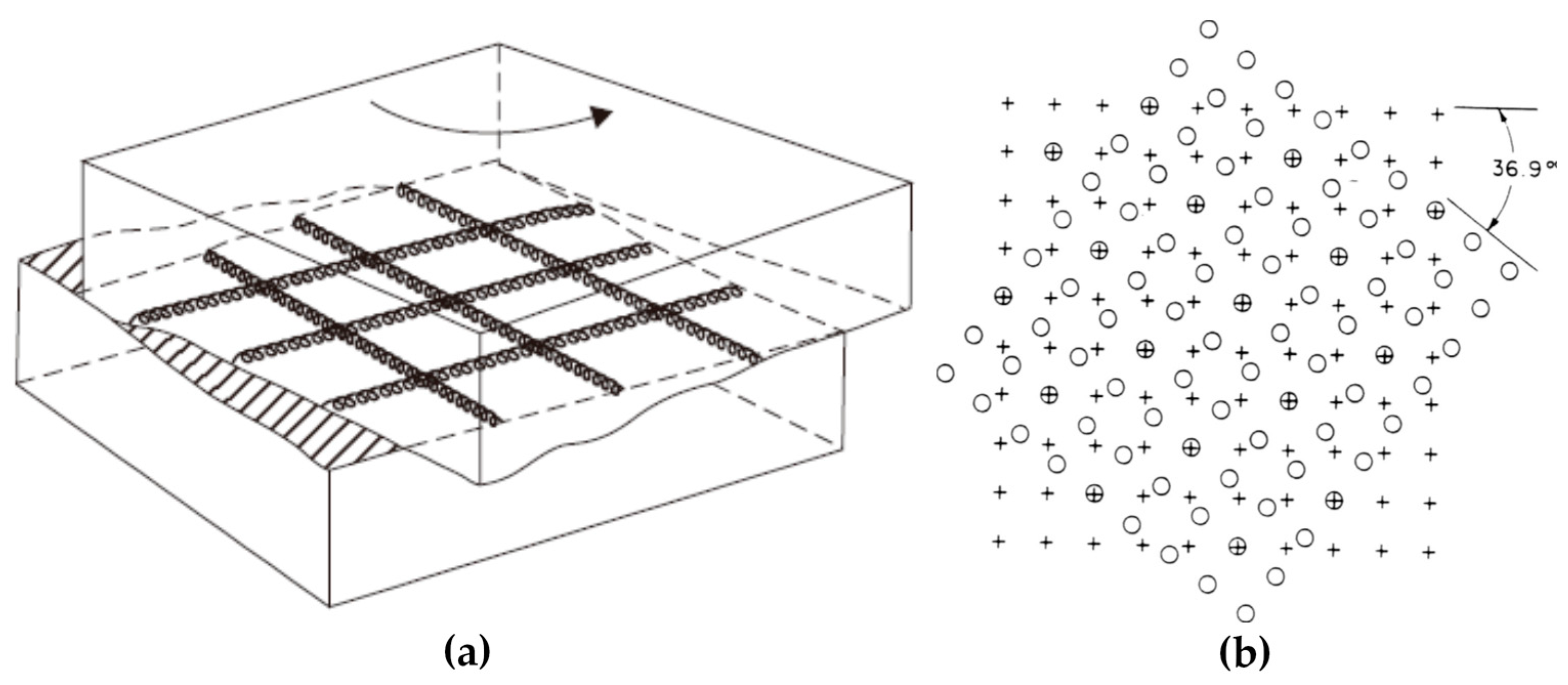
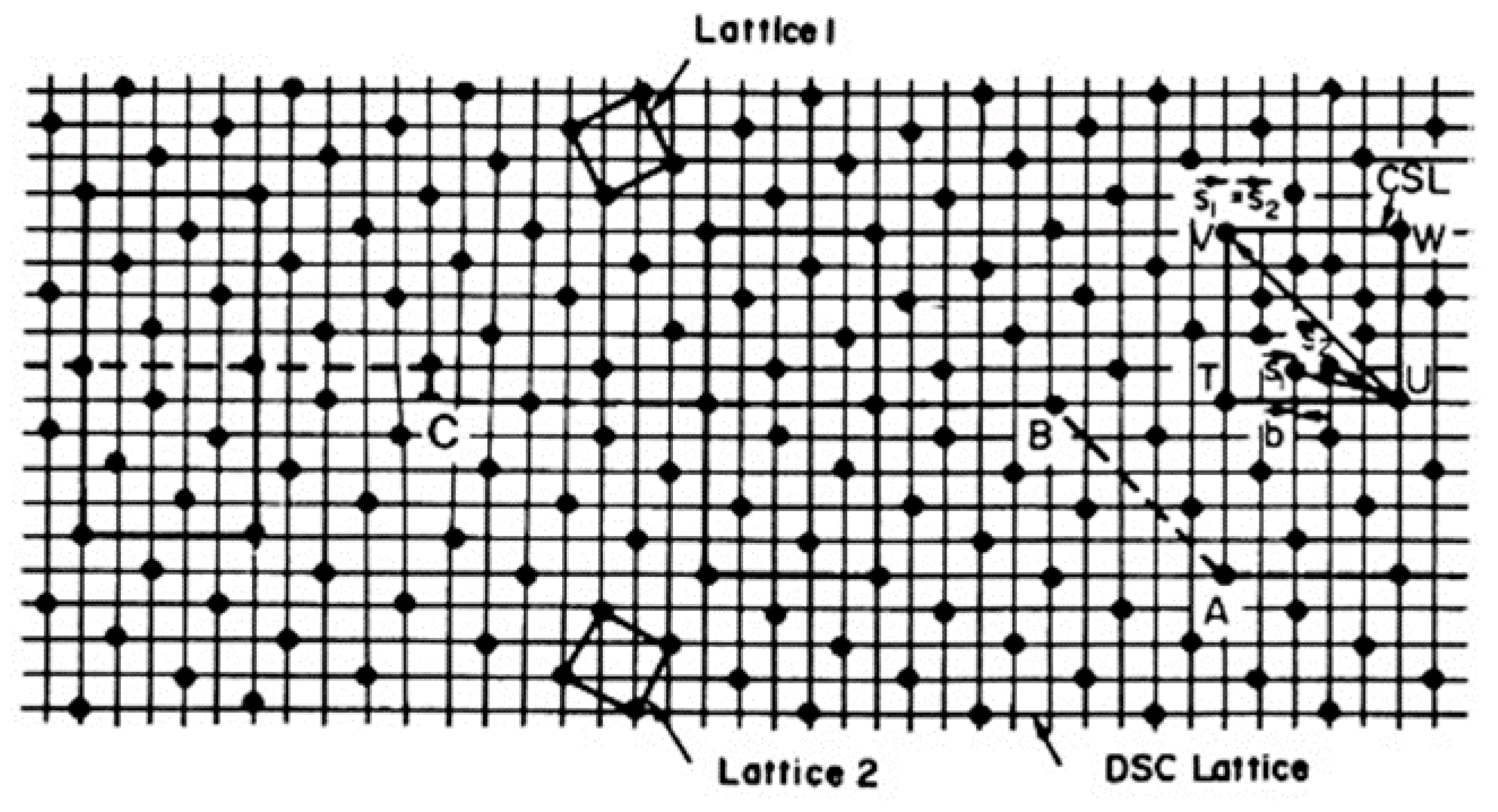
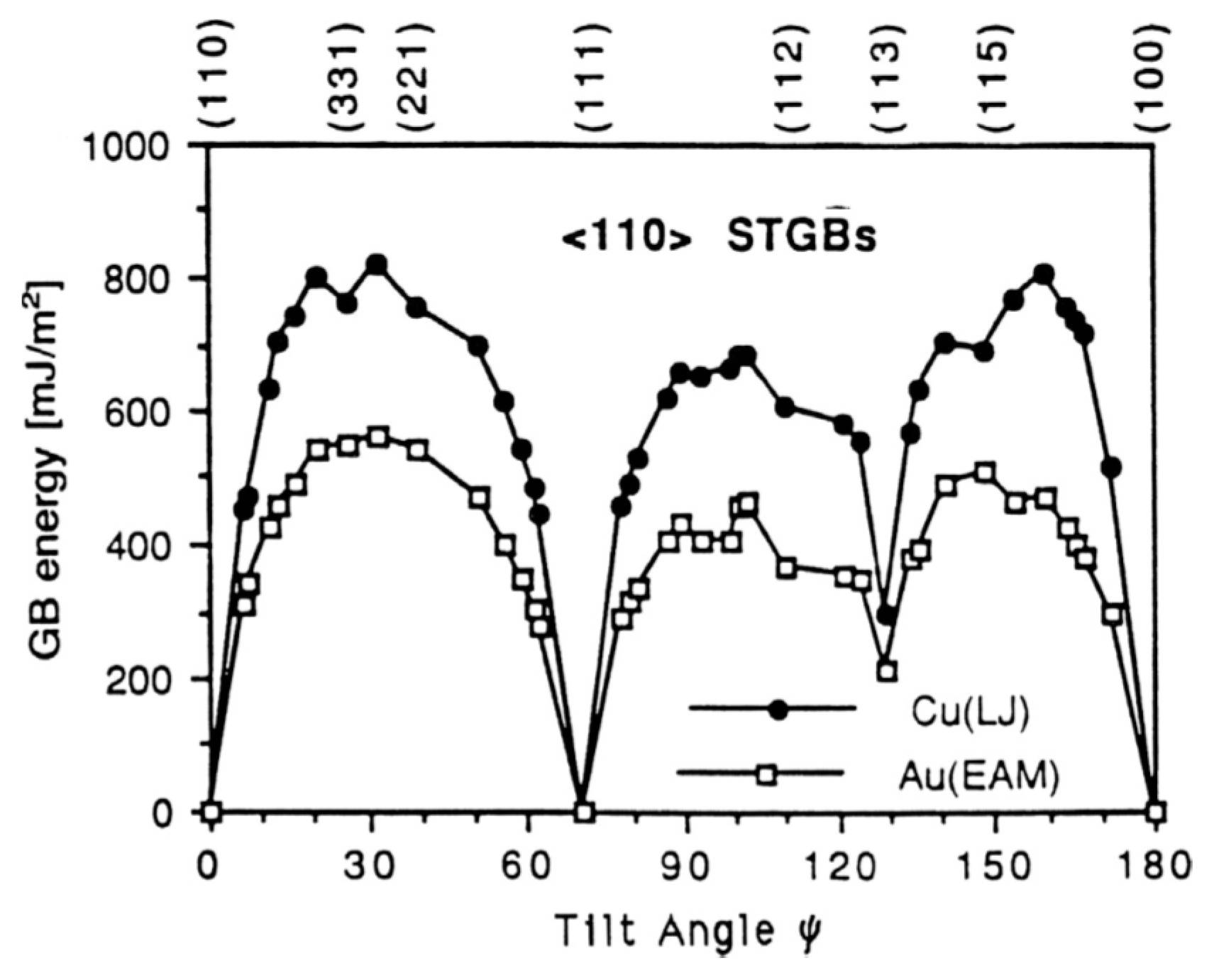
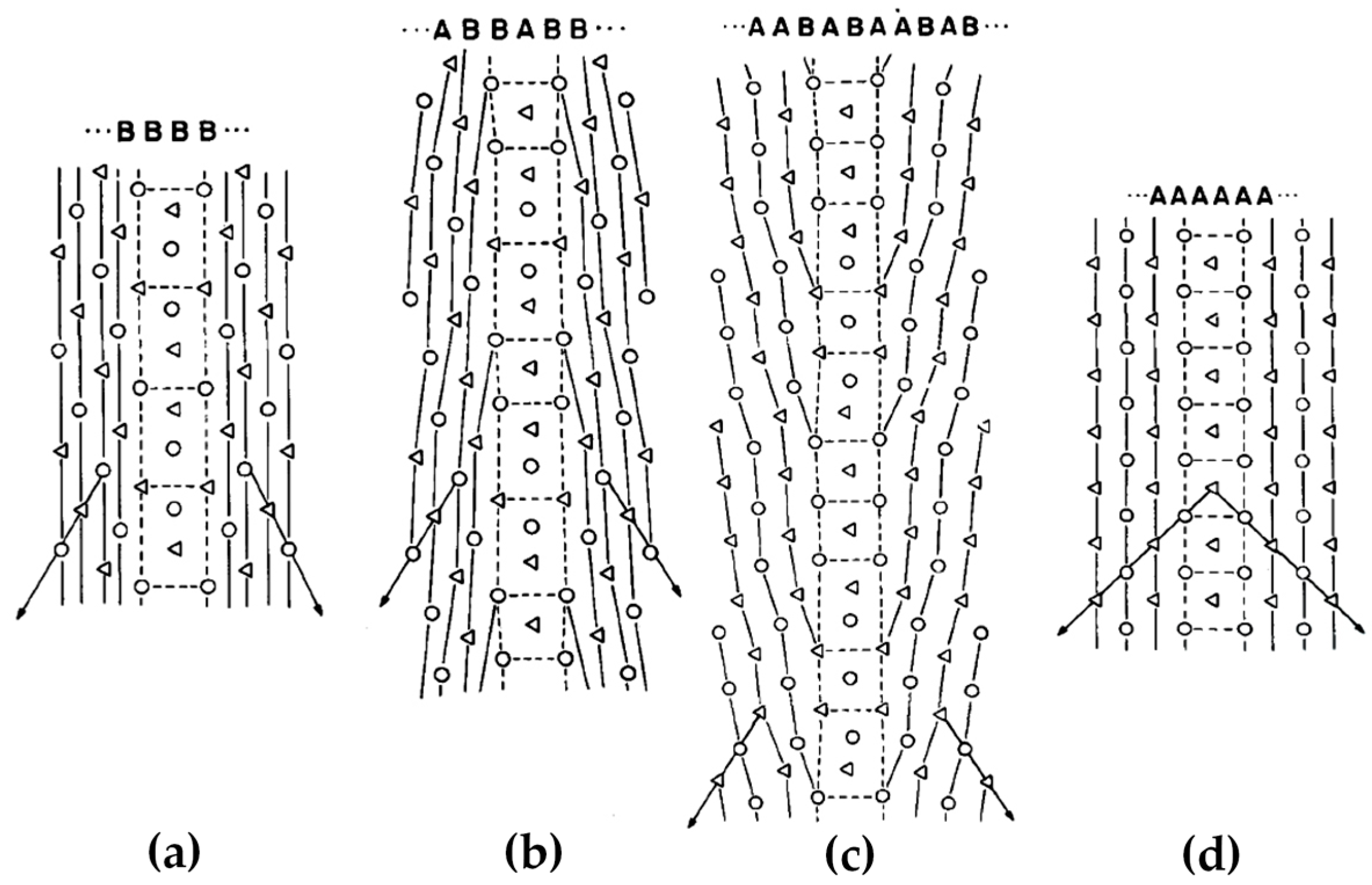
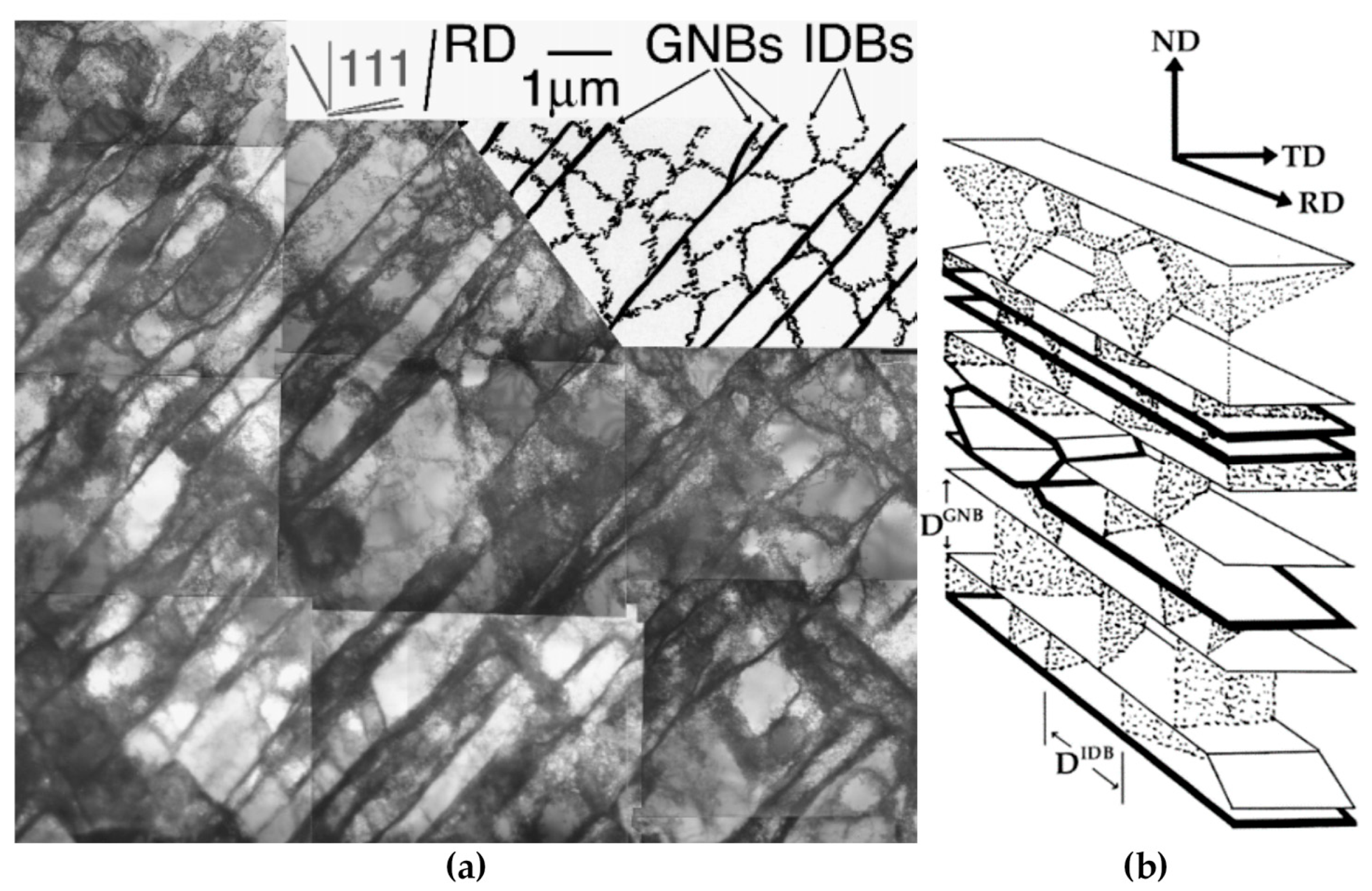
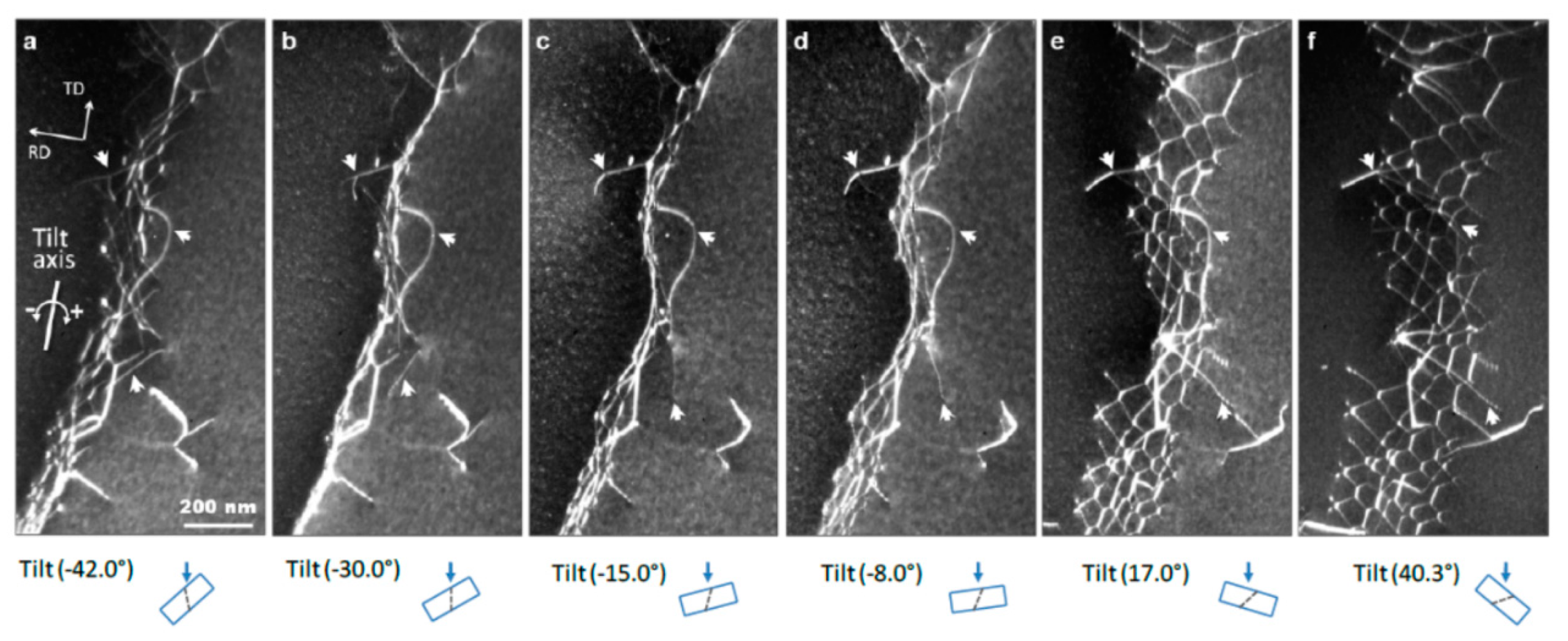
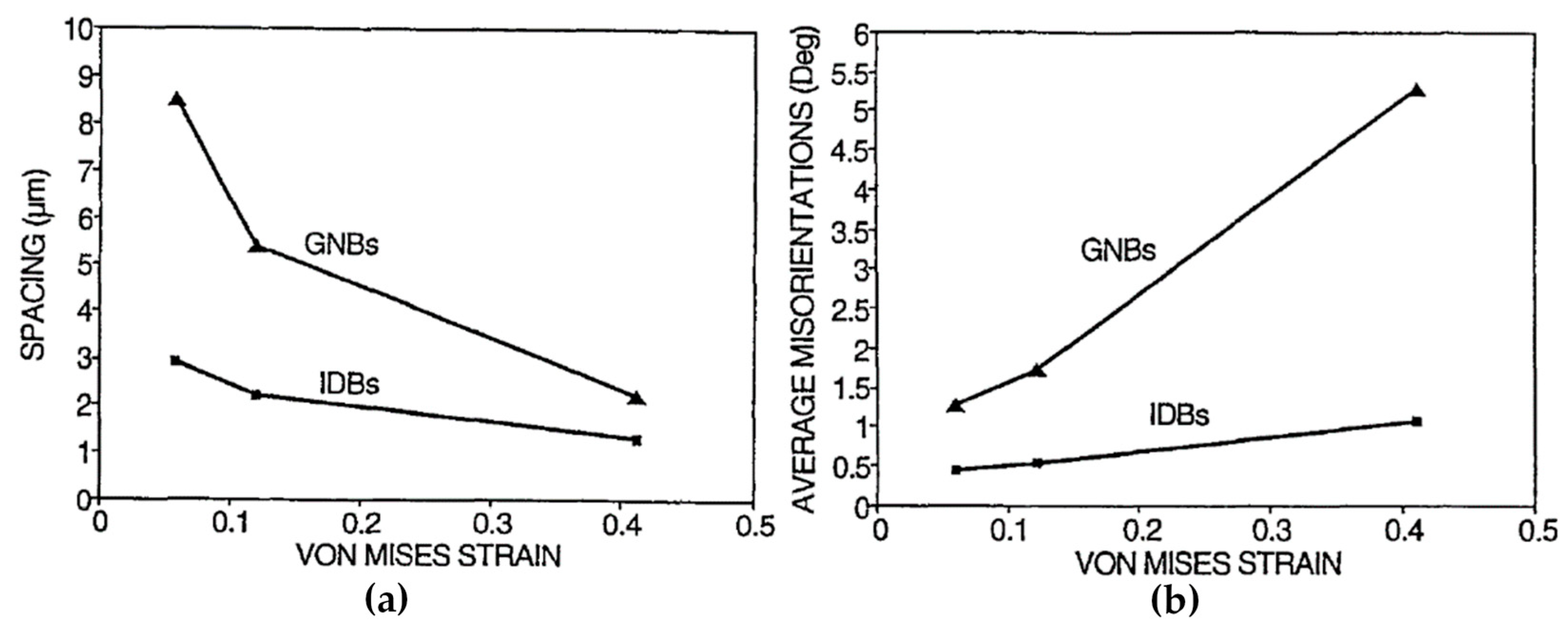
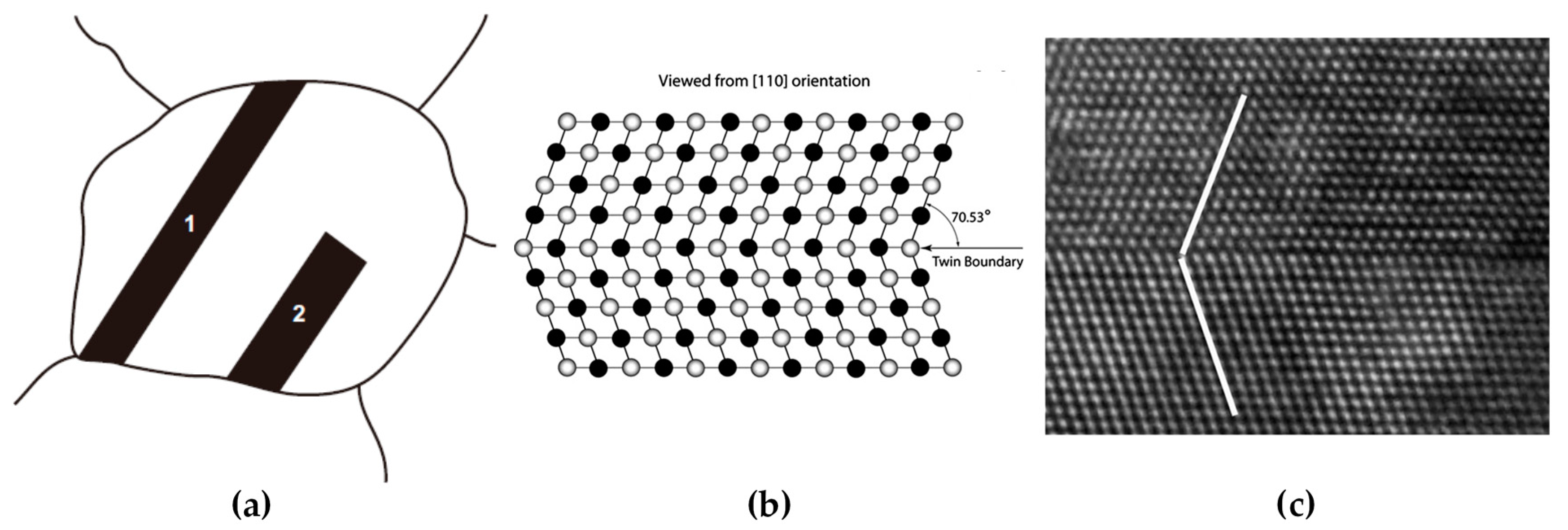

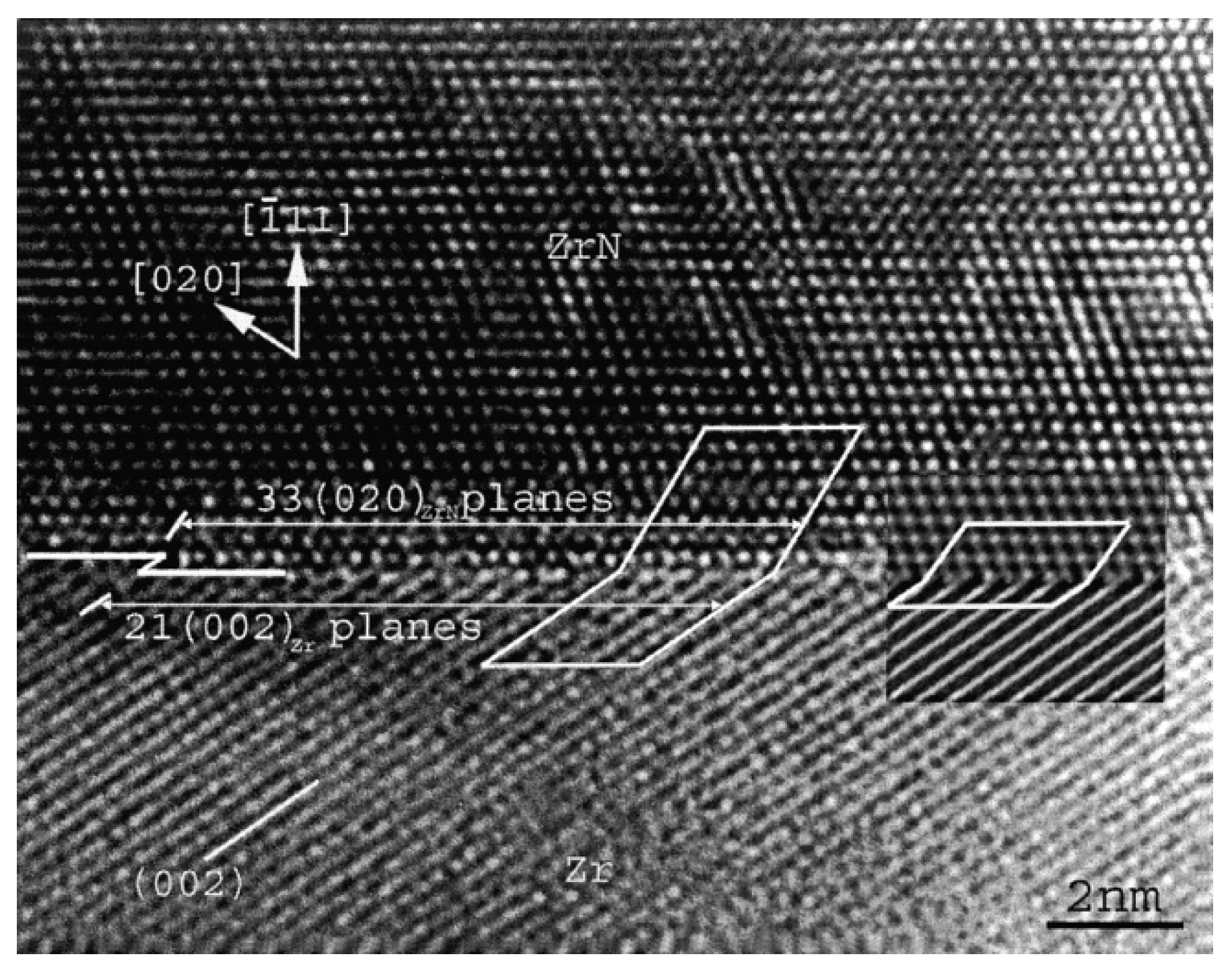
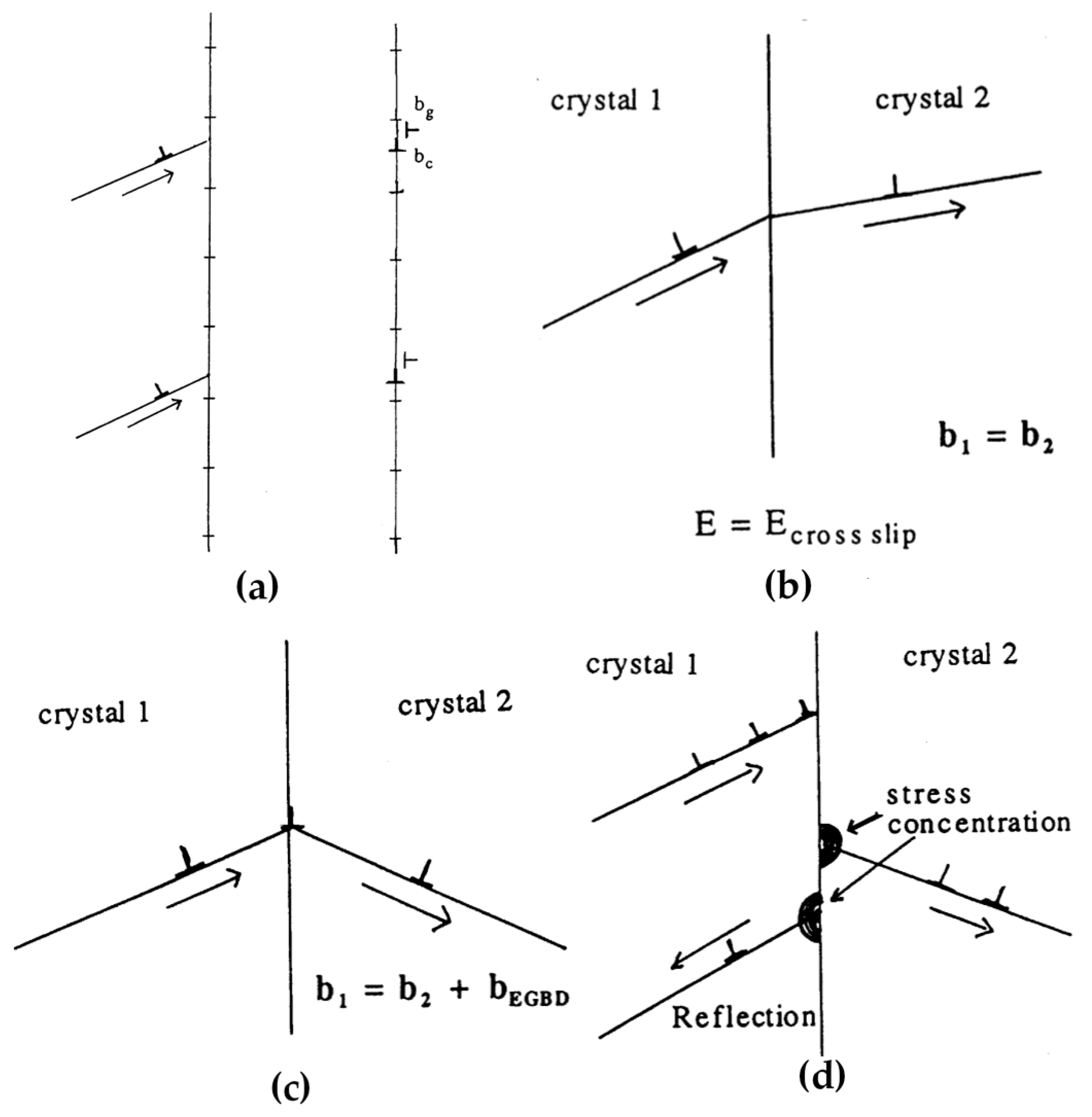
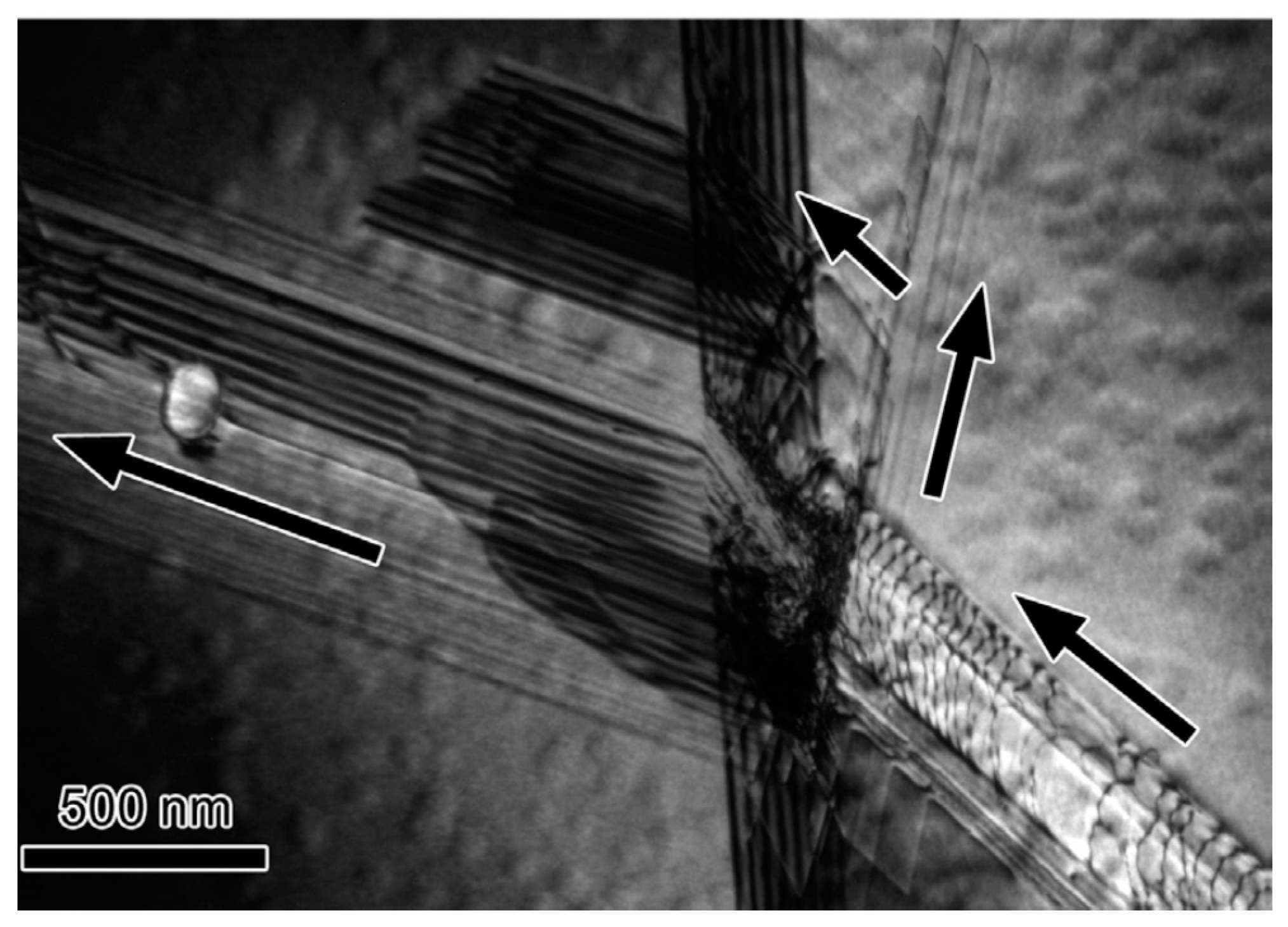
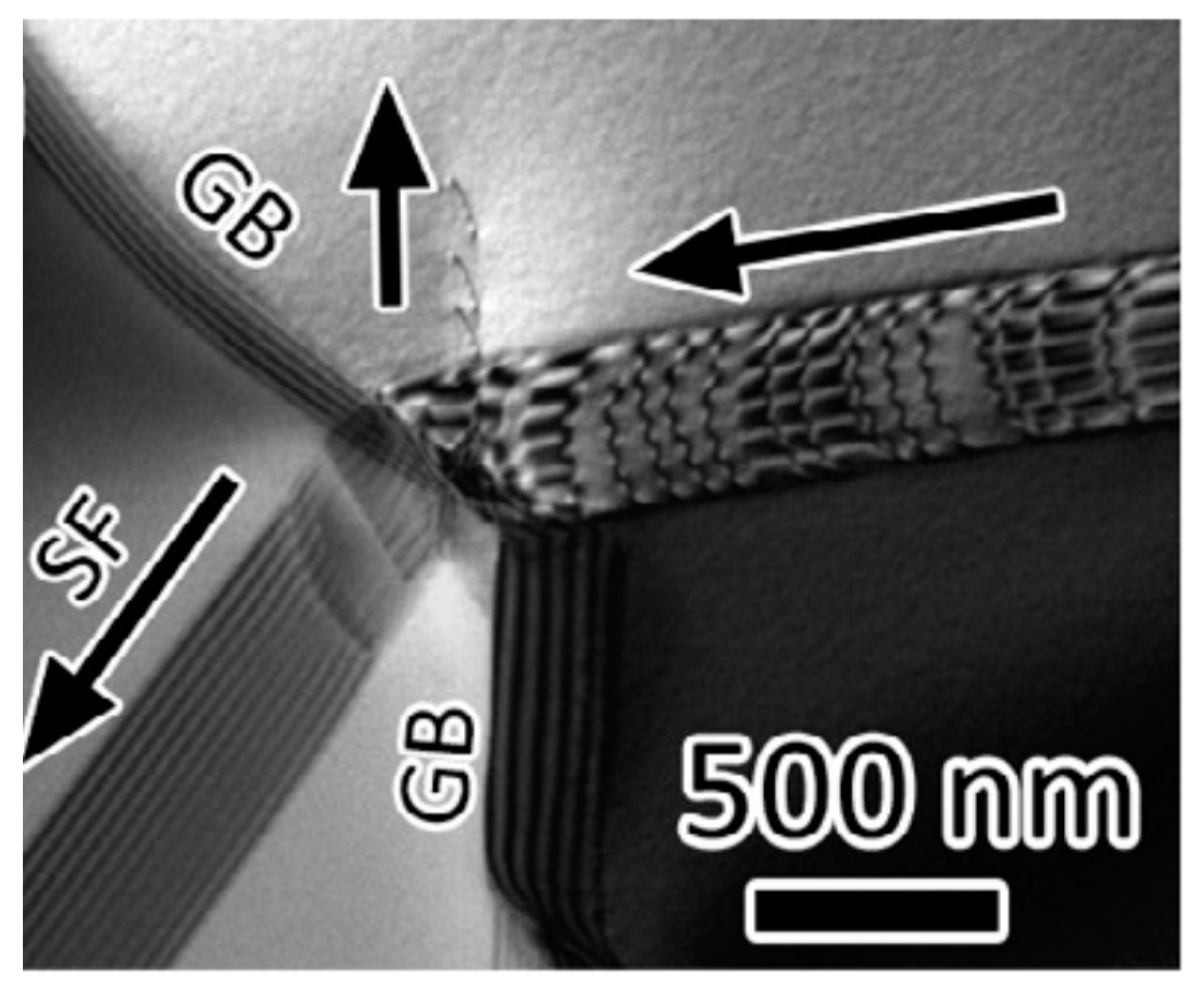
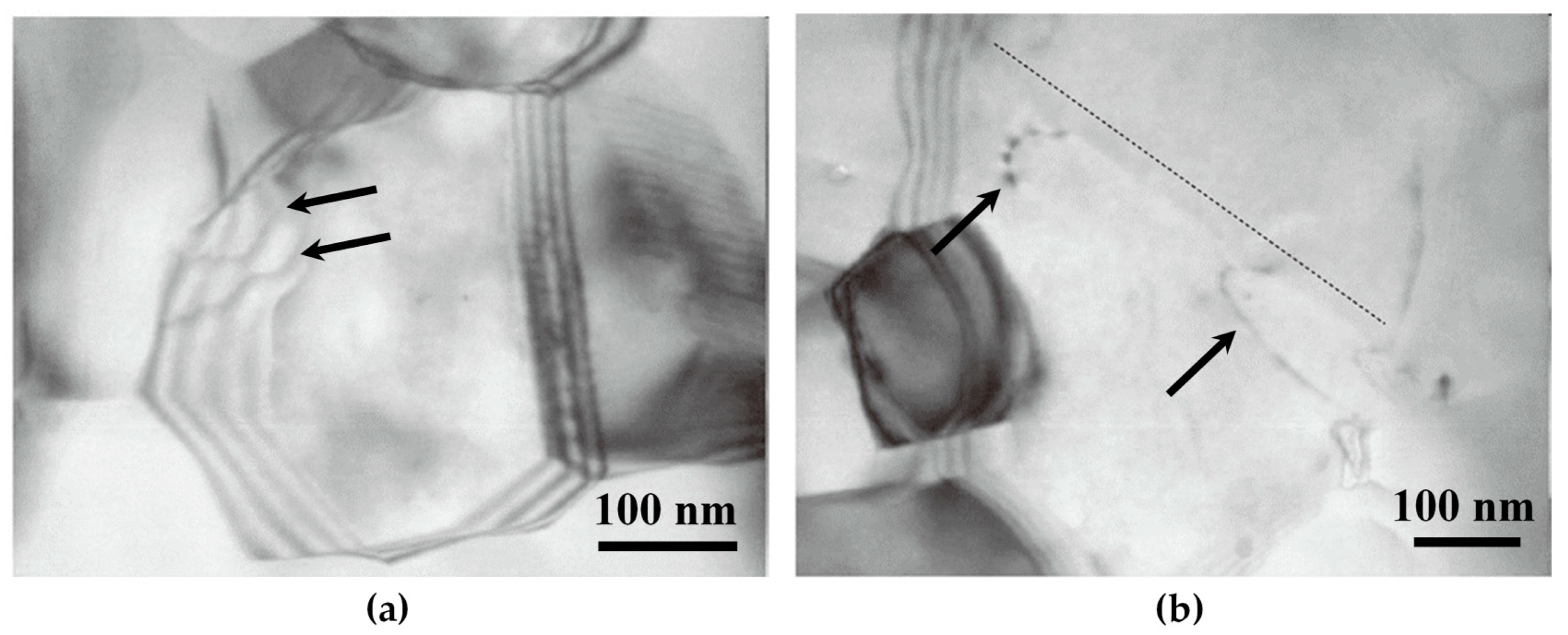

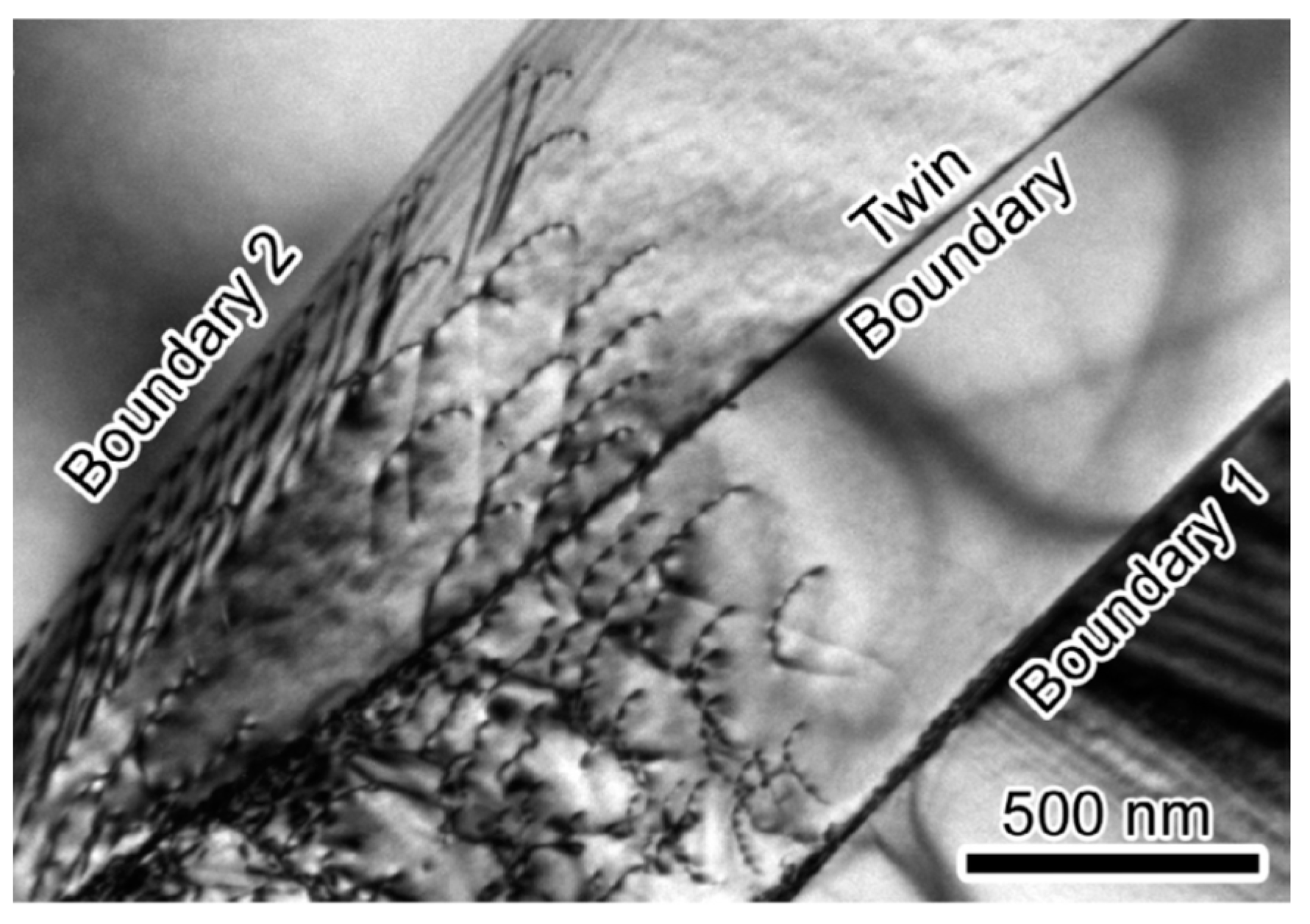
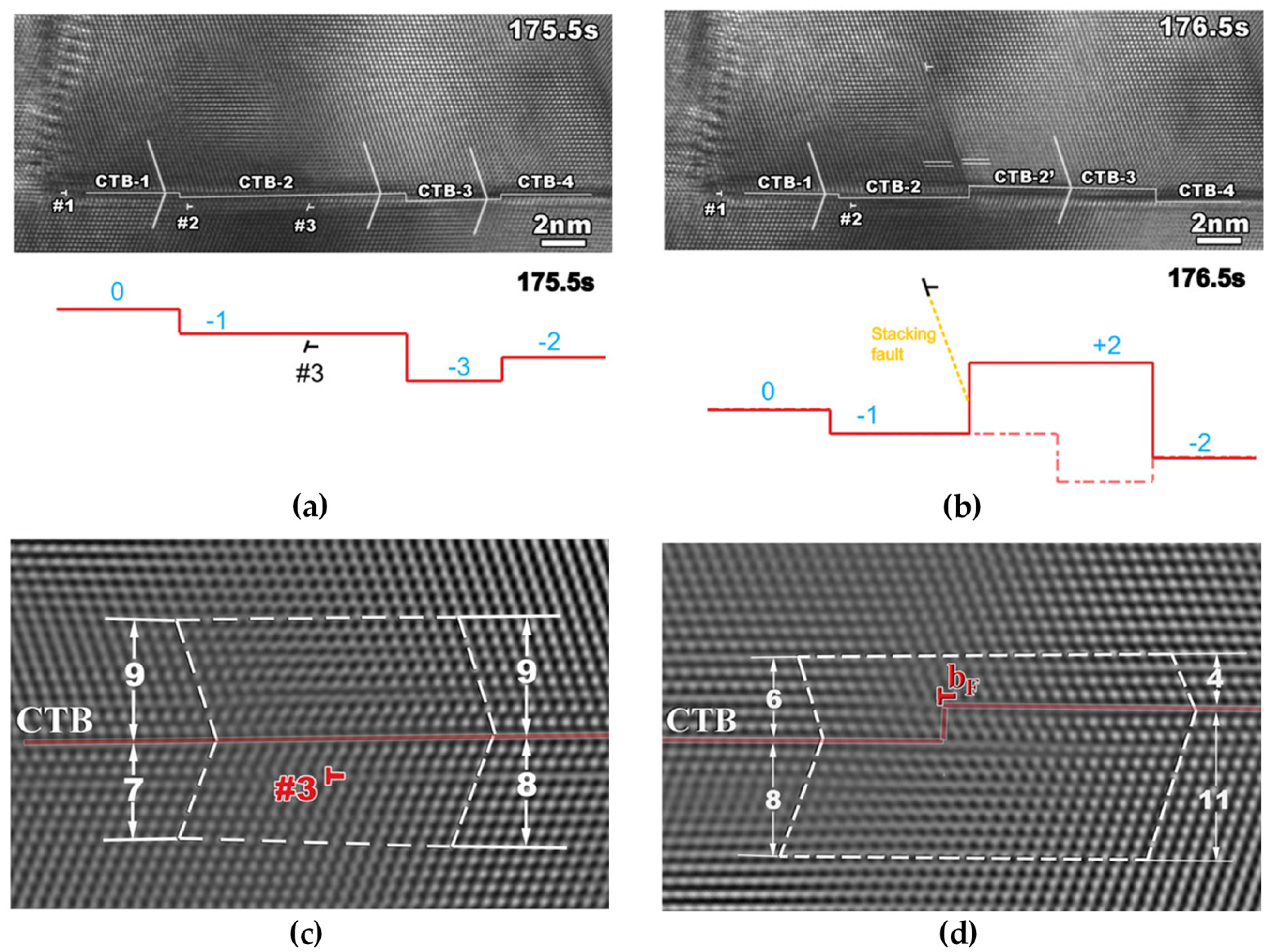

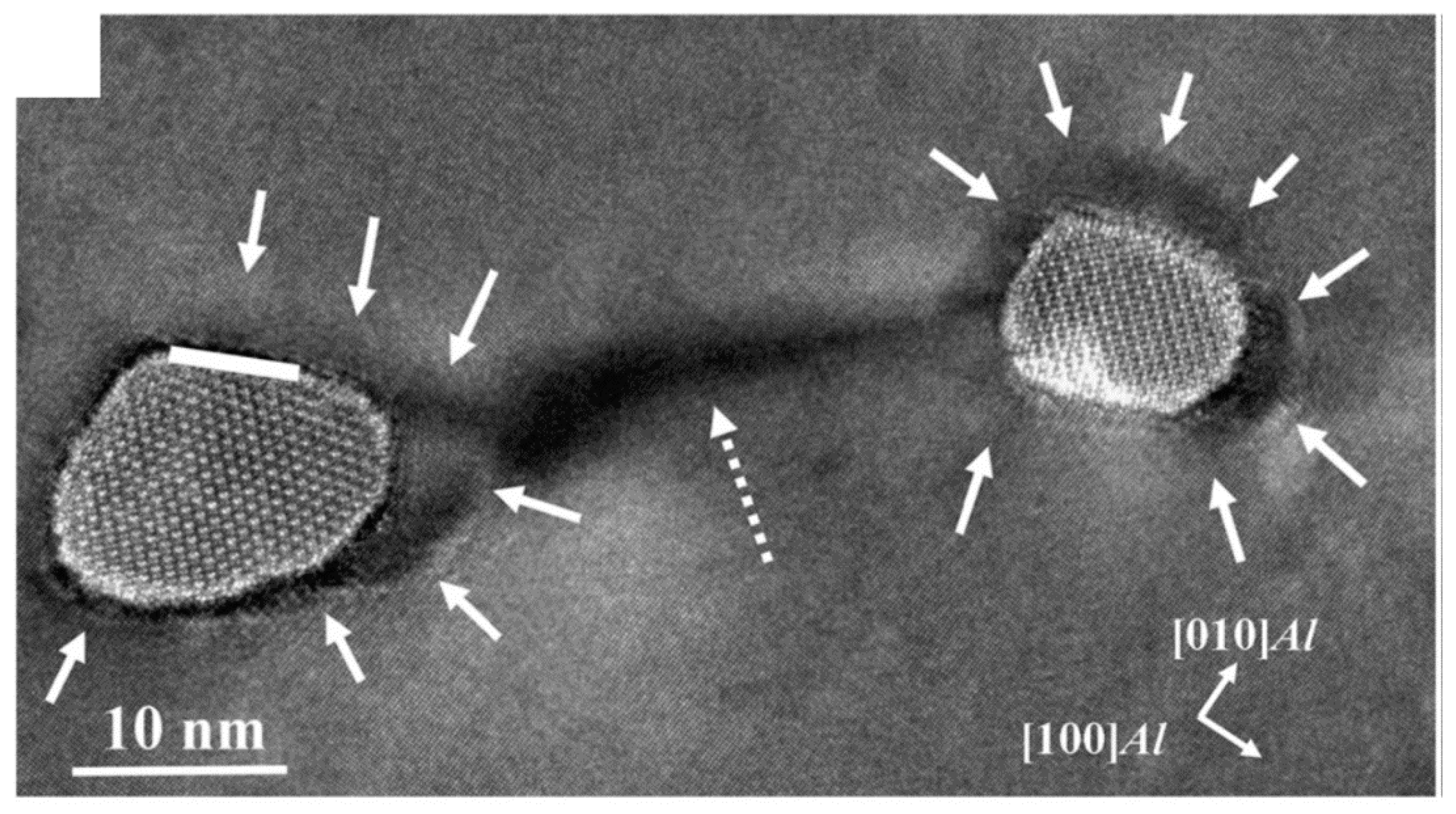
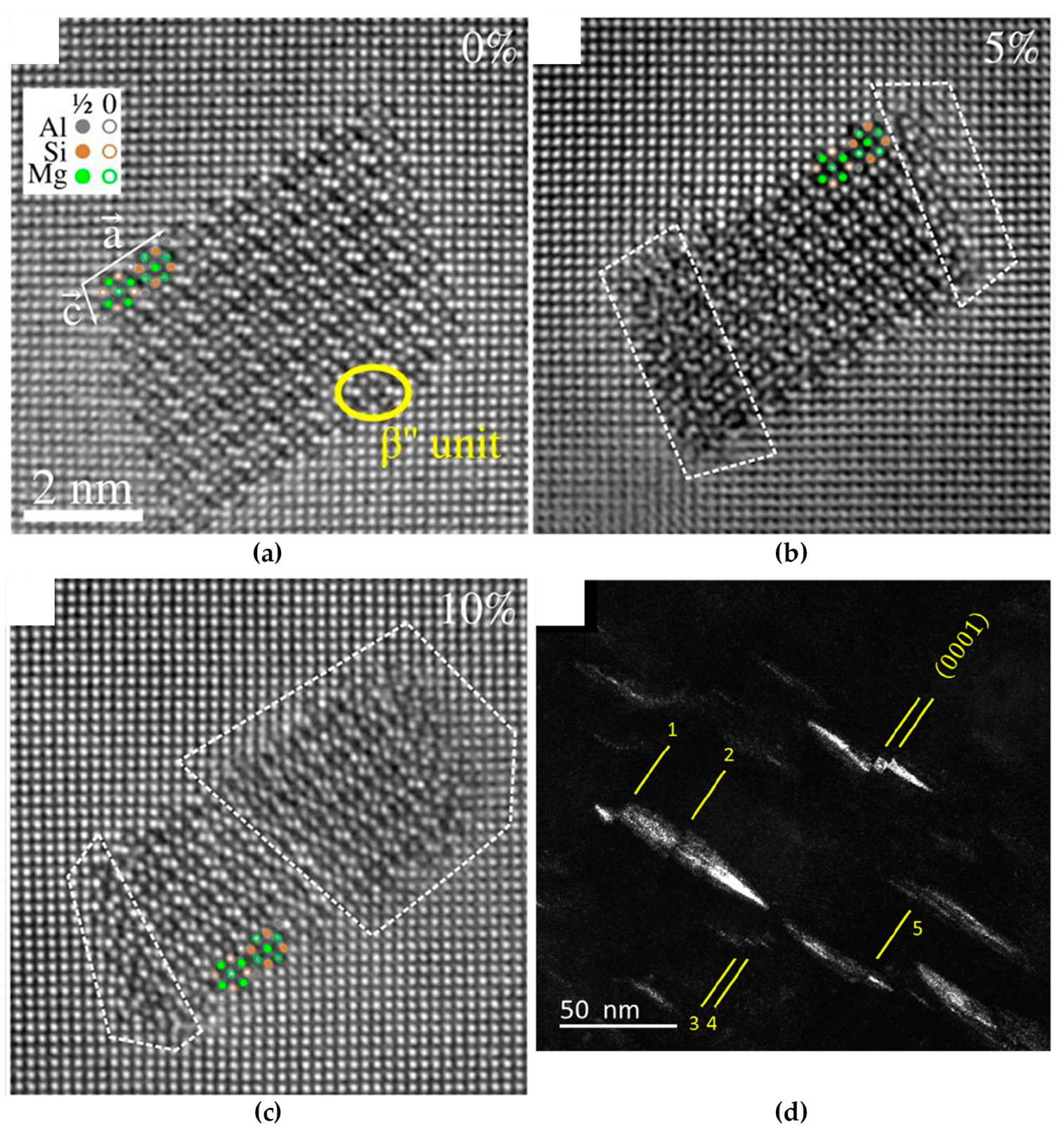
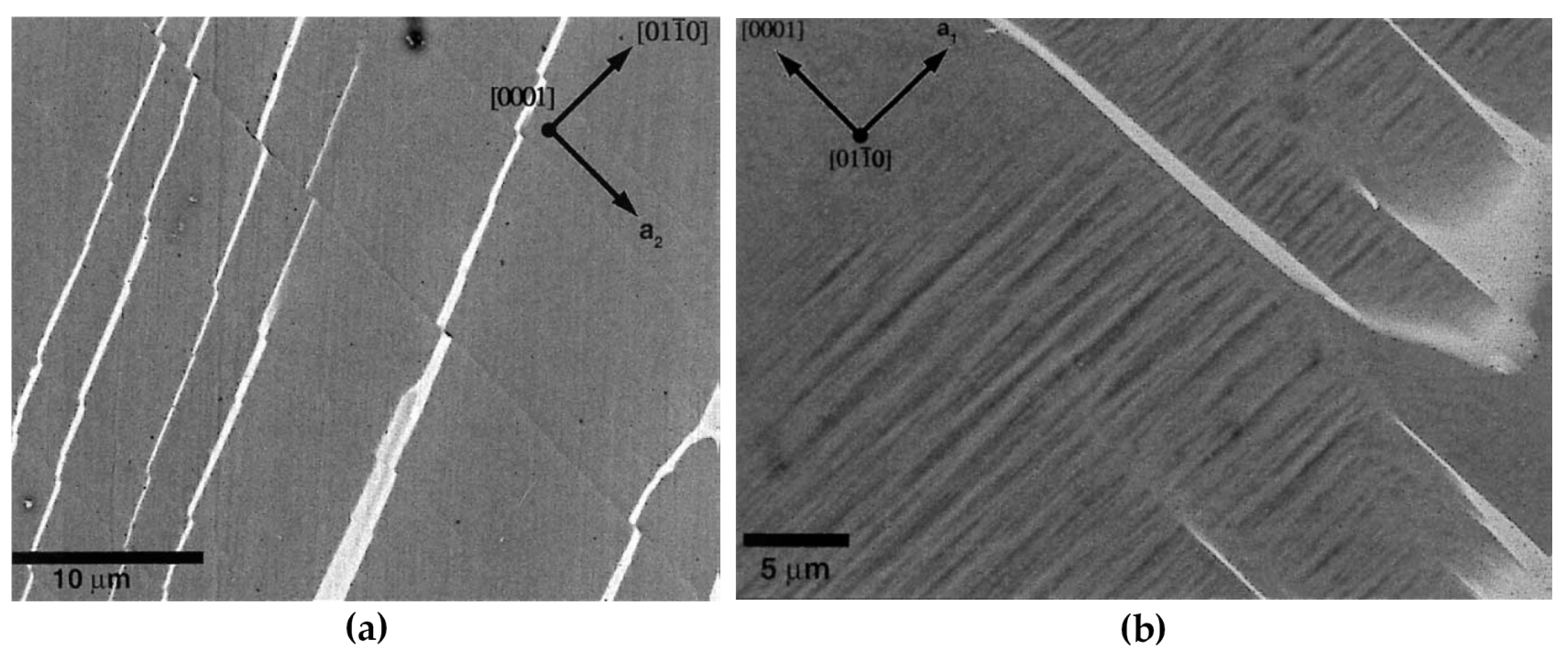

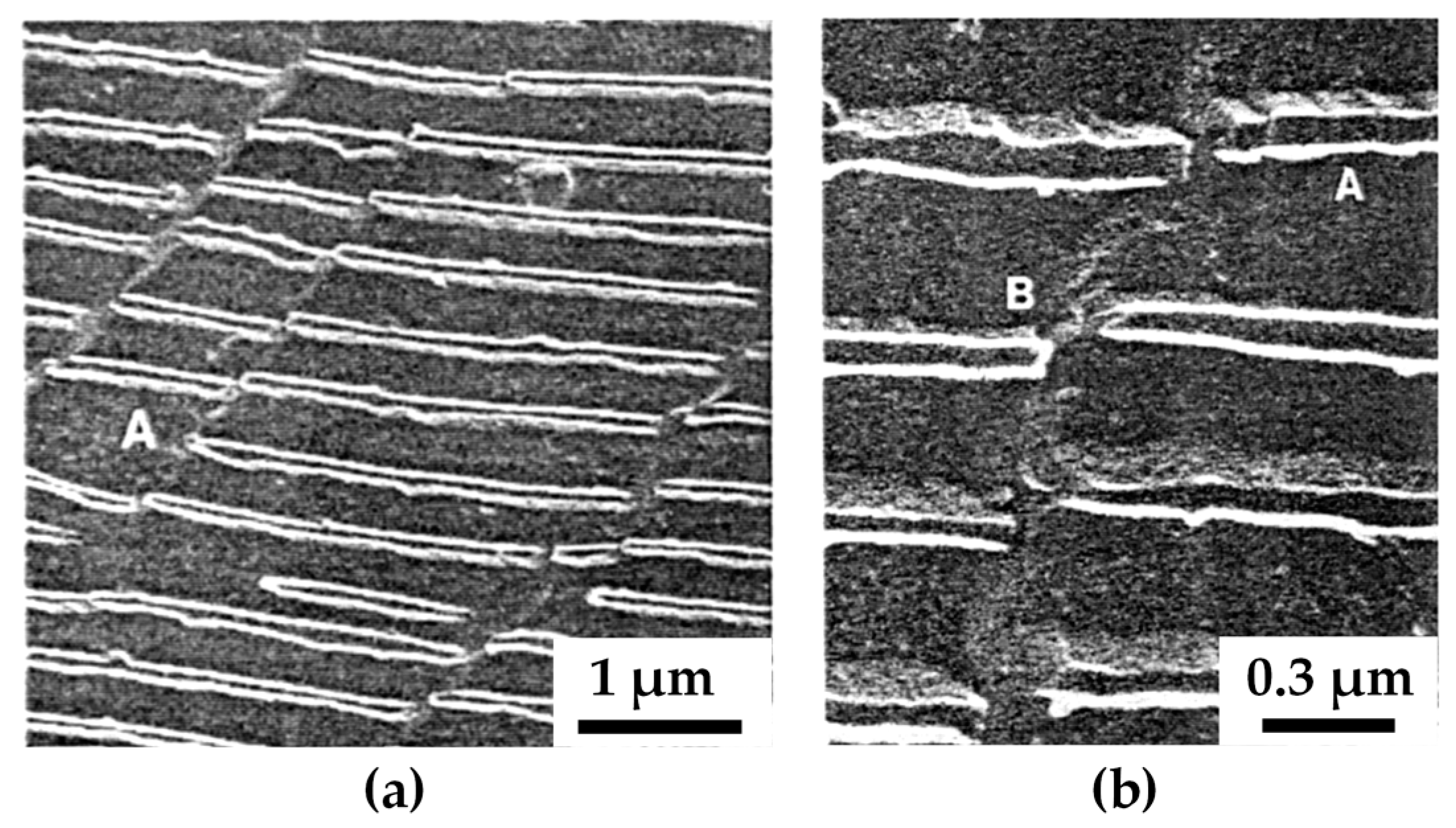
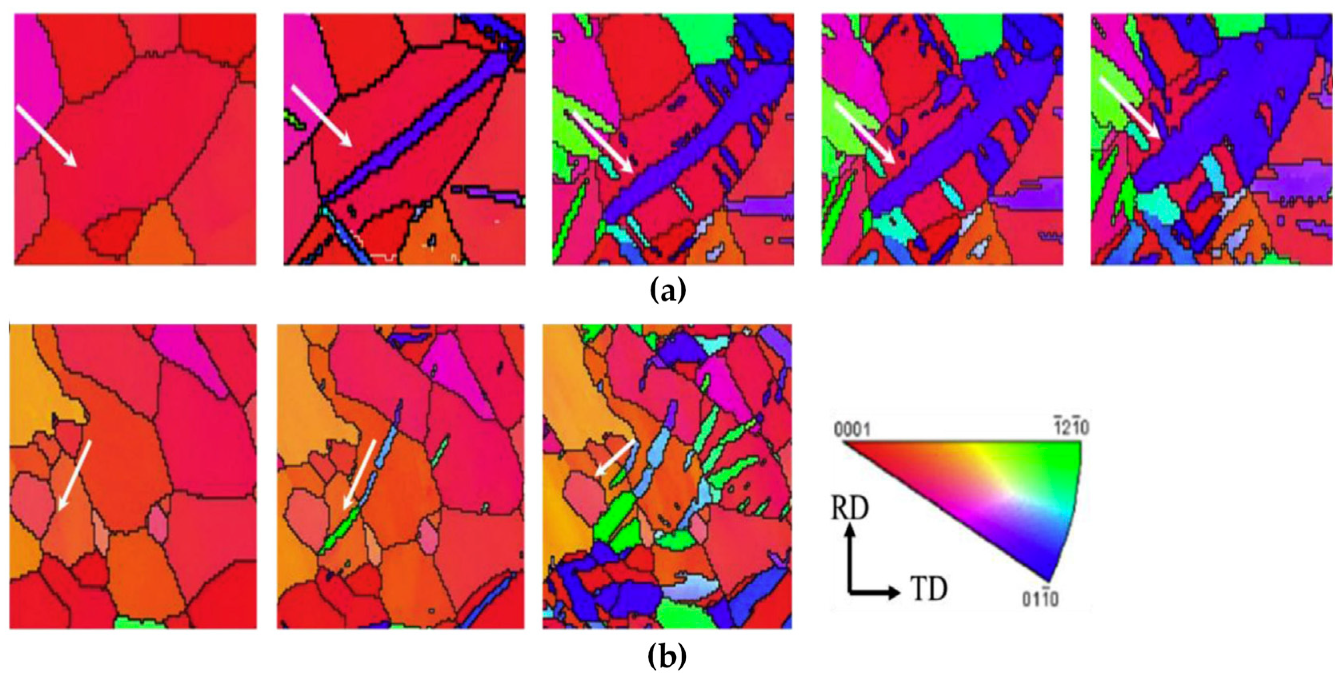
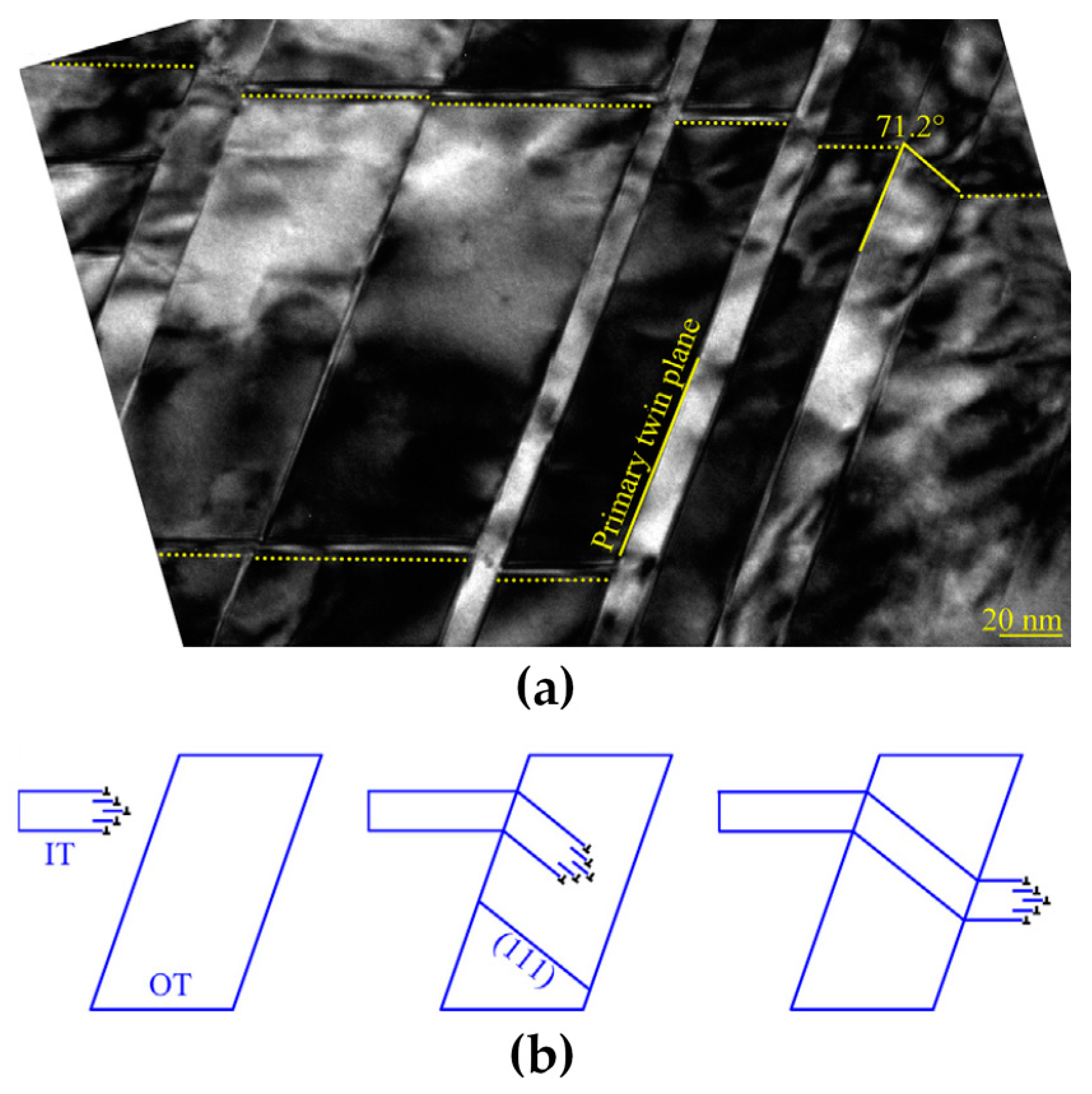
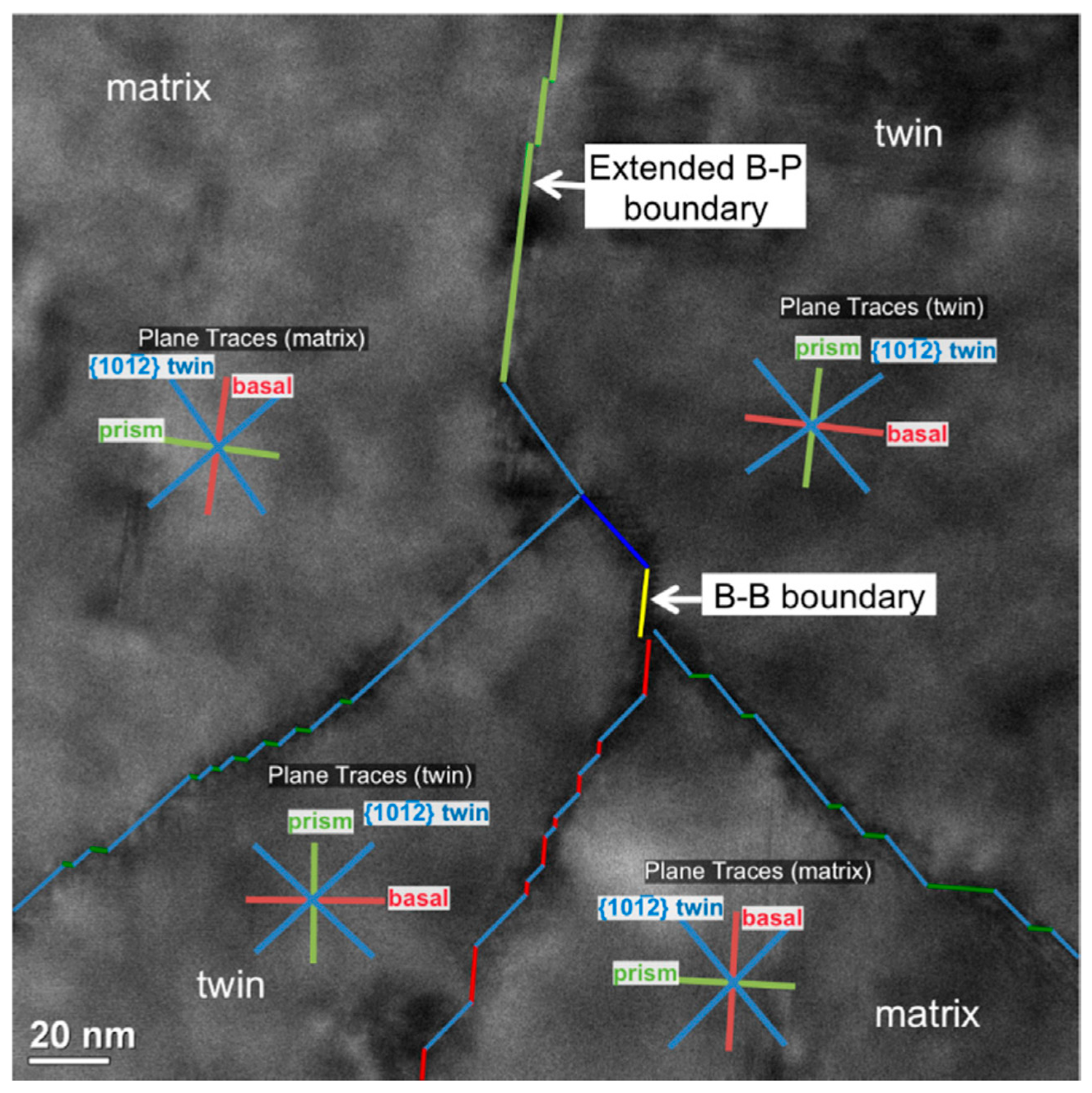
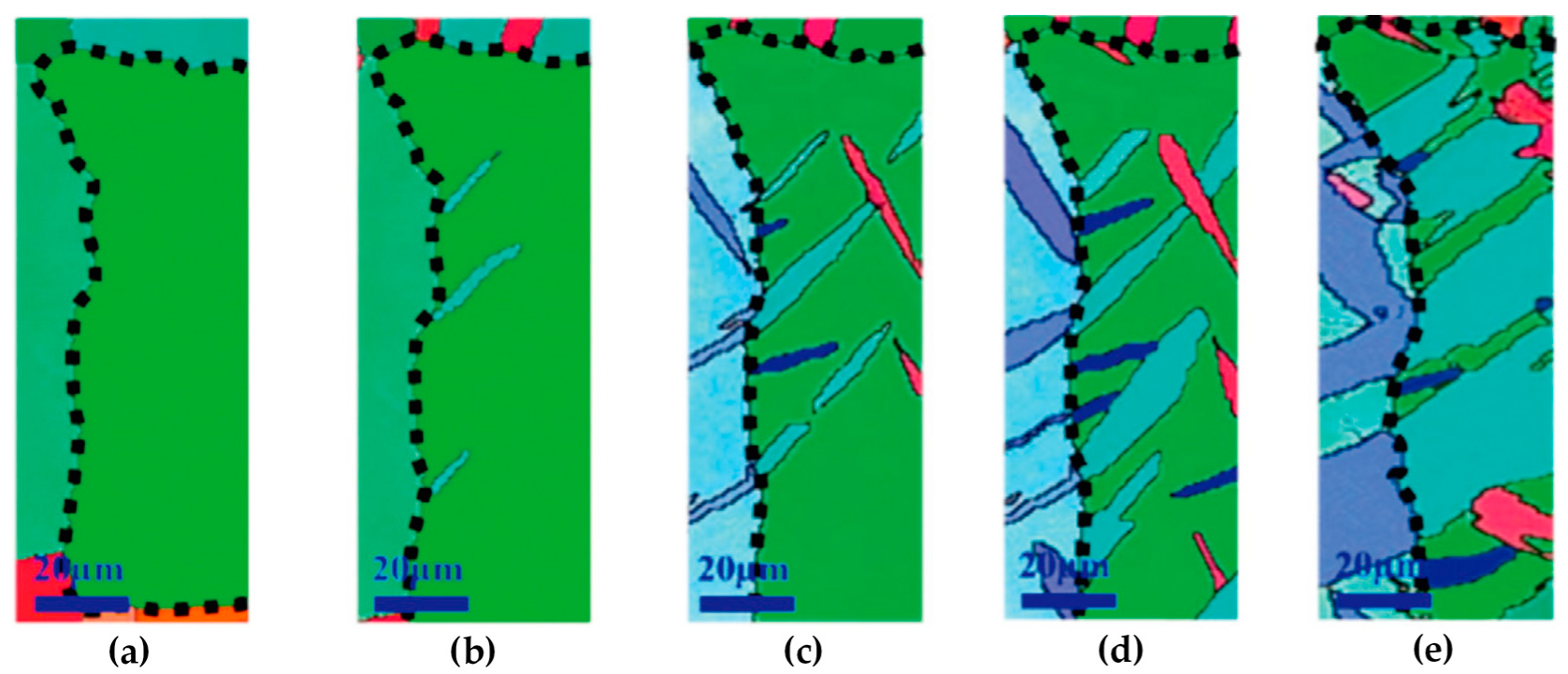
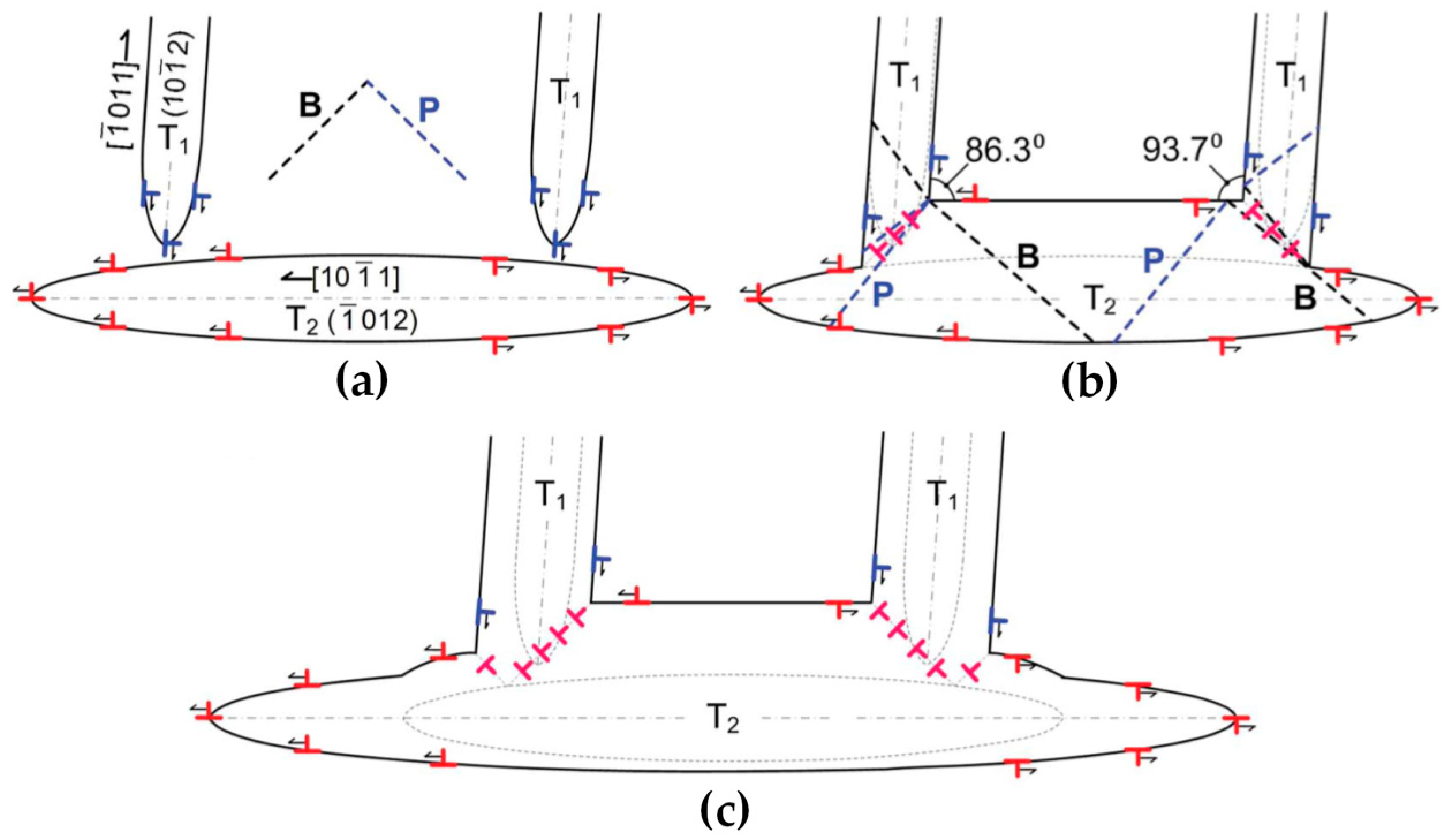
Publisher’s Note: MDPI stays neutral with regard to jurisdictional claims in published maps and institutional affiliations. |
© 2021 by the authors. Licensee MDPI, Basel, Switzerland. This article is an open access article distributed under the terms and conditions of the Creative Commons Attribution (CC BY) license (http://creativecommons.org/licenses/by/4.0/).
Share and Cite
Pan, H.; He, Y.; Zhang, X. Interactions between Dislocations and Boundaries during Deformation. Materials 2021, 14, 1012. https://doi.org/10.3390/ma14041012
Pan H, He Y, Zhang X. Interactions between Dislocations and Boundaries during Deformation. Materials. 2021; 14(4):1012. https://doi.org/10.3390/ma14041012
Chicago/Turabian StylePan, Hongjiang, Yue He, and Xiaodan Zhang. 2021. "Interactions between Dislocations and Boundaries during Deformation" Materials 14, no. 4: 1012. https://doi.org/10.3390/ma14041012
APA StylePan, H., He, Y., & Zhang, X. (2021). Interactions between Dislocations and Boundaries during Deformation. Materials, 14(4), 1012. https://doi.org/10.3390/ma14041012




